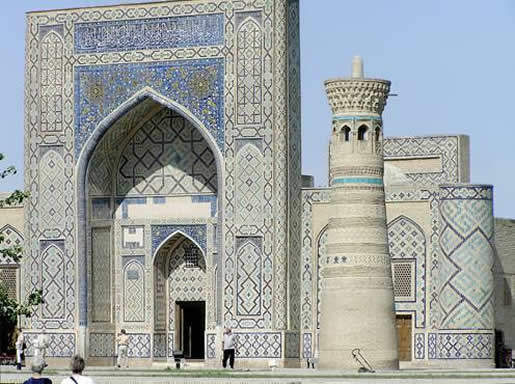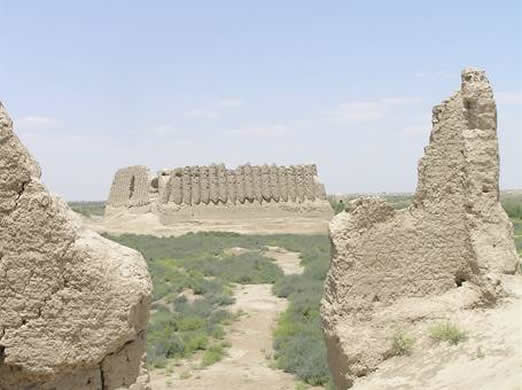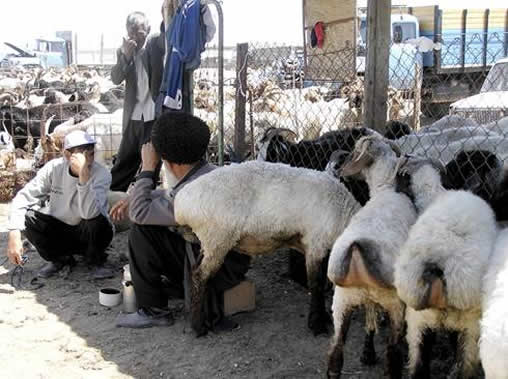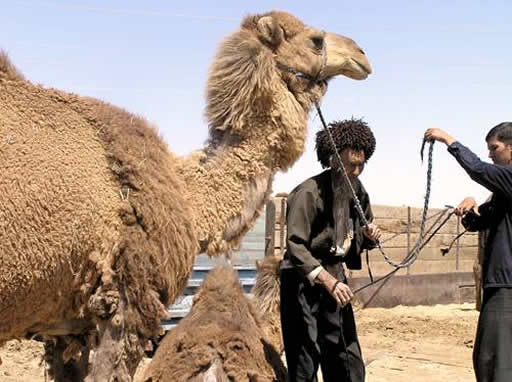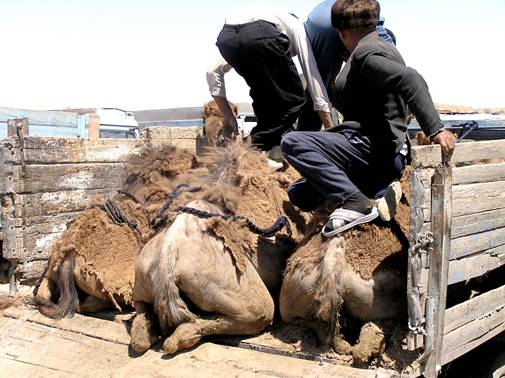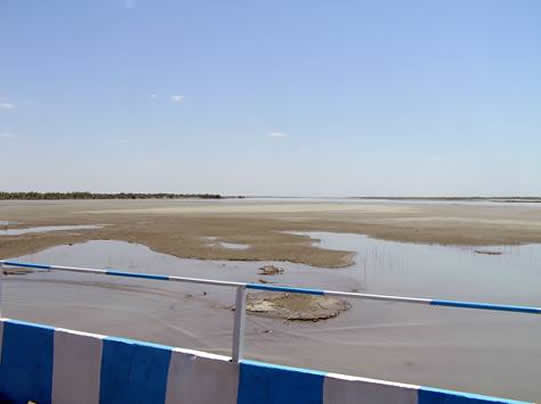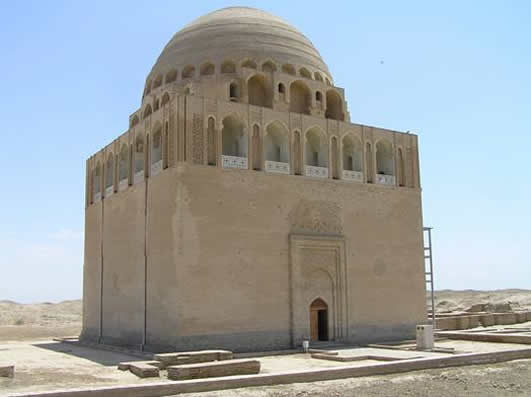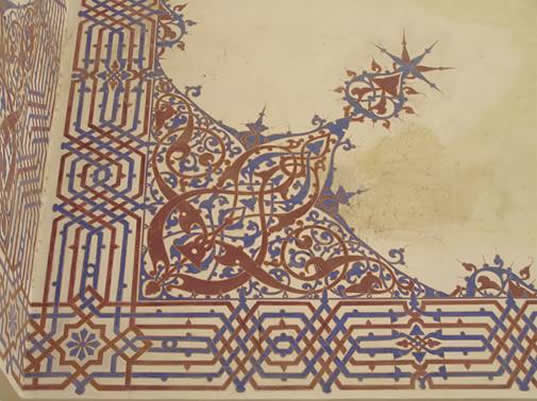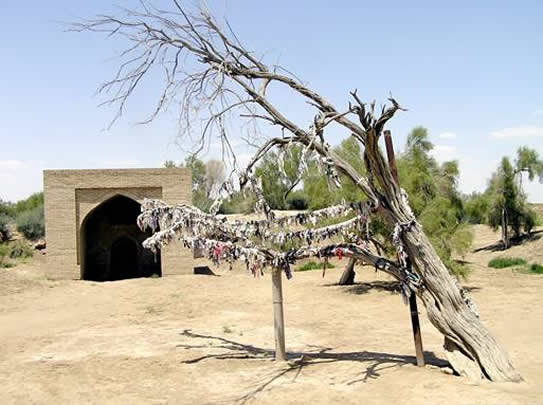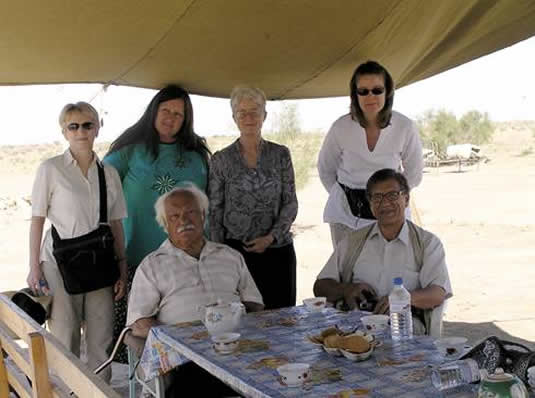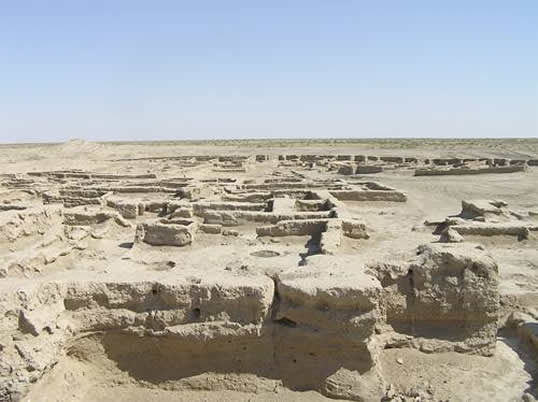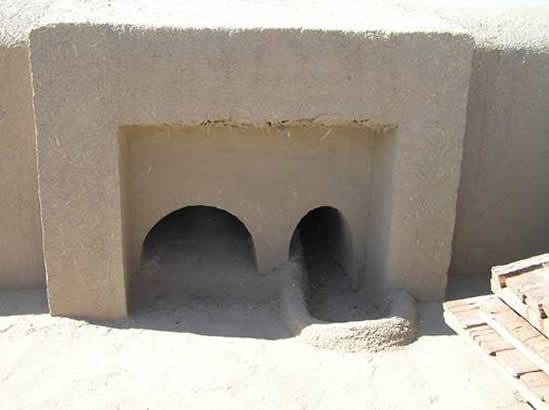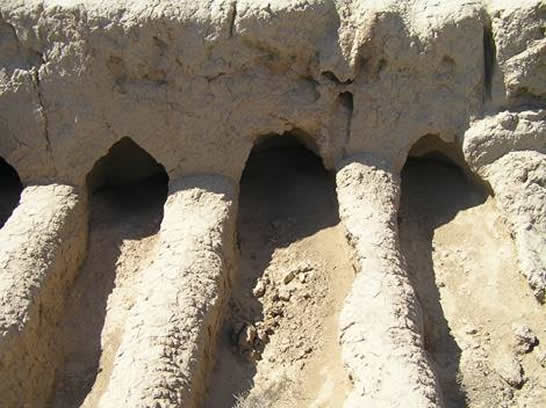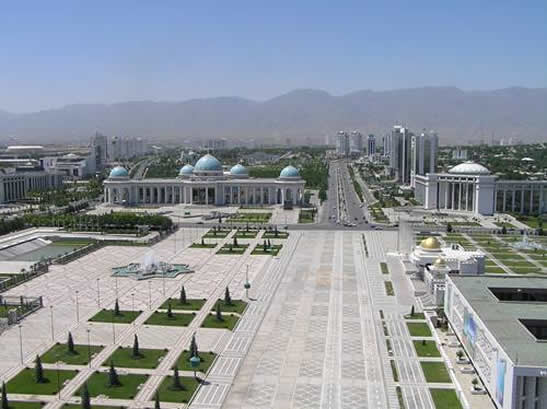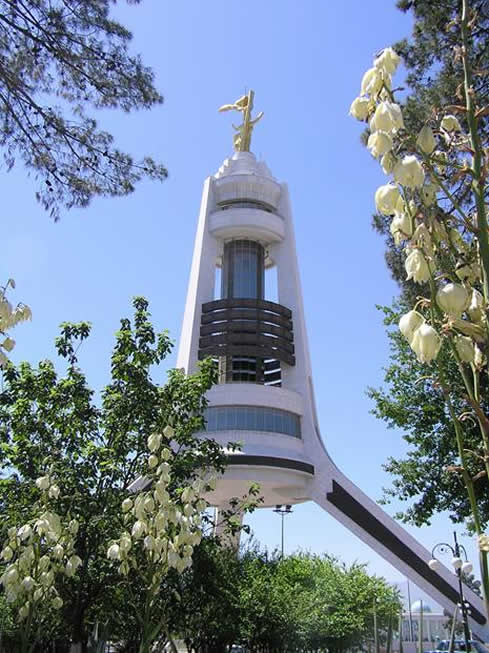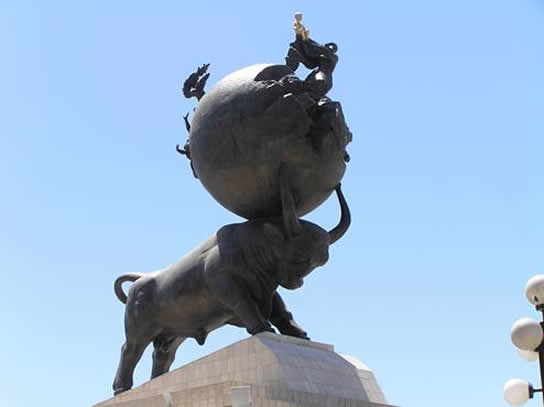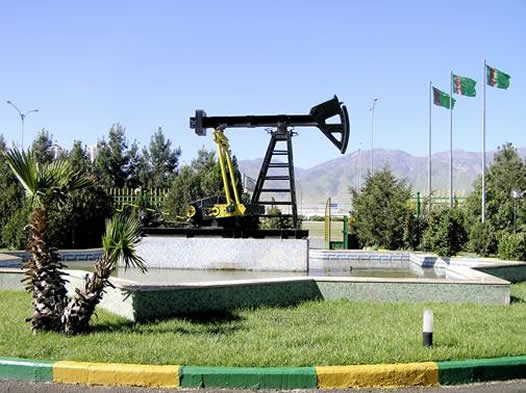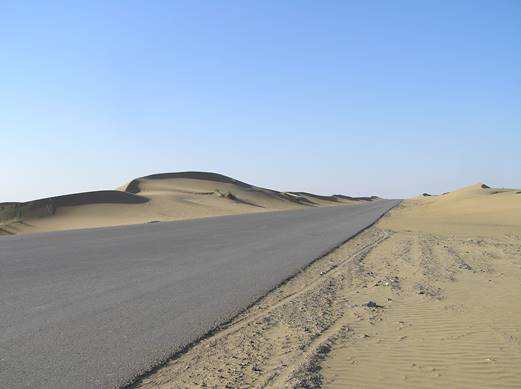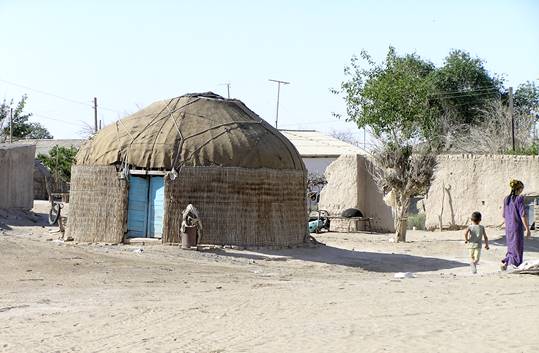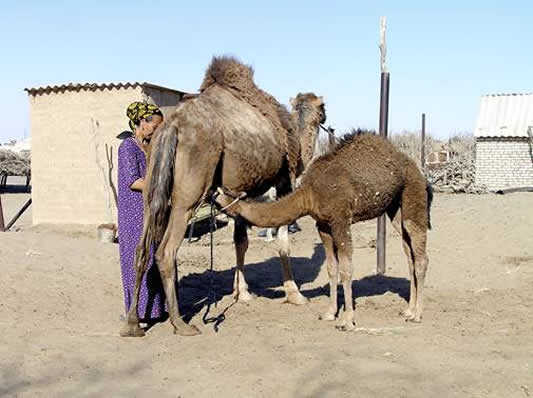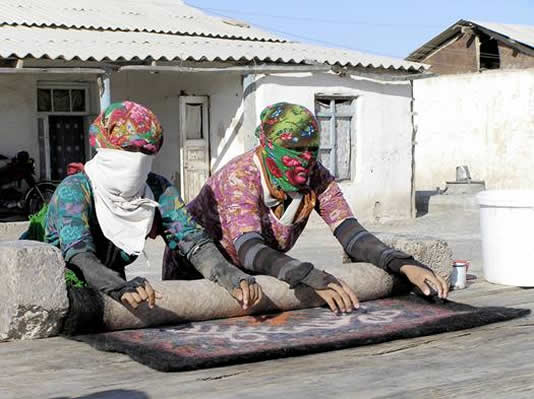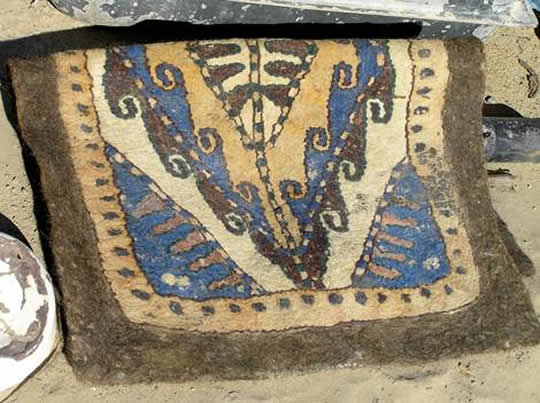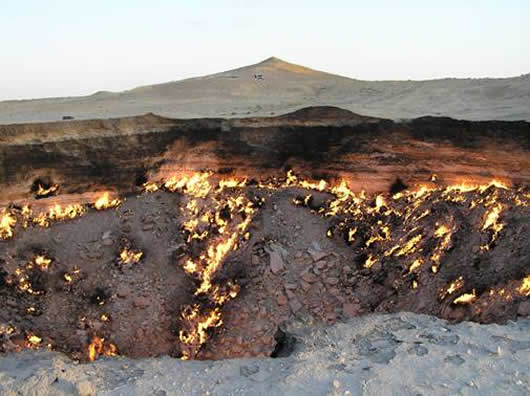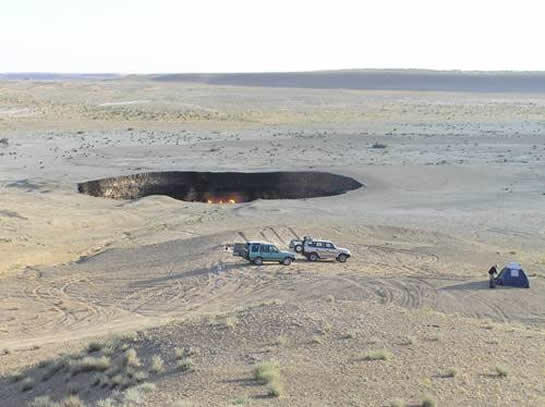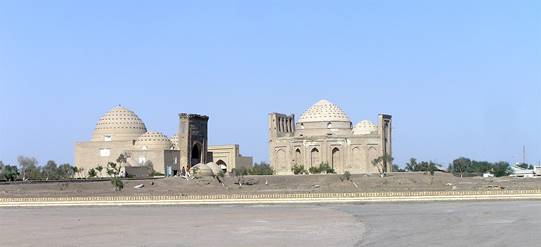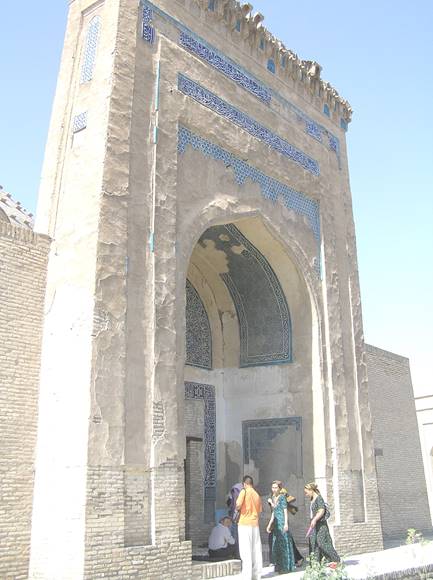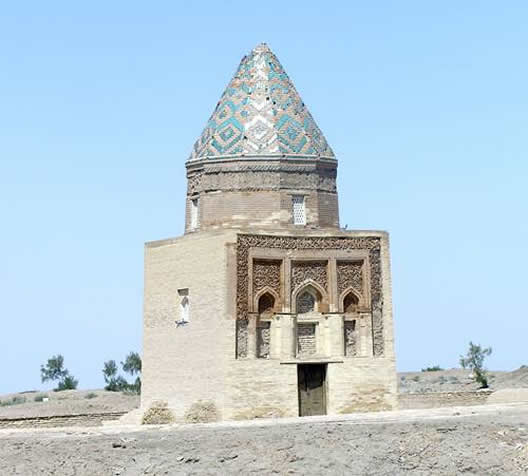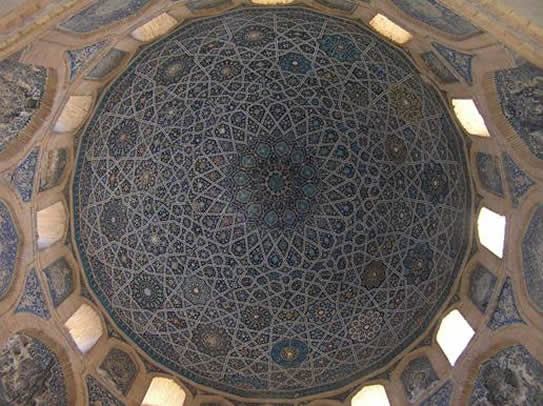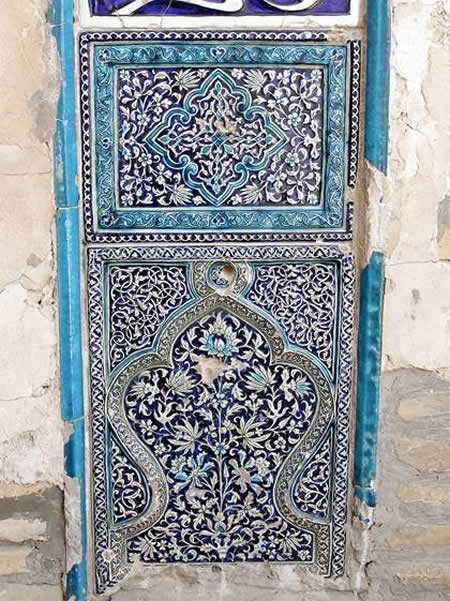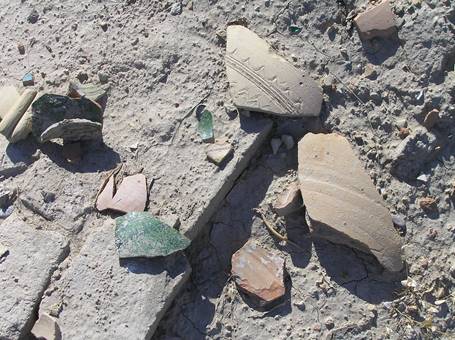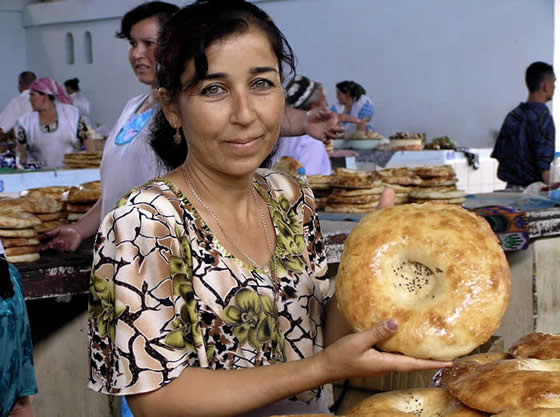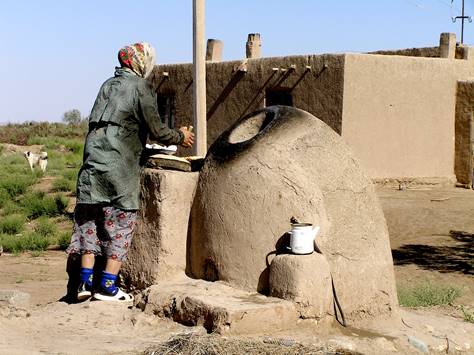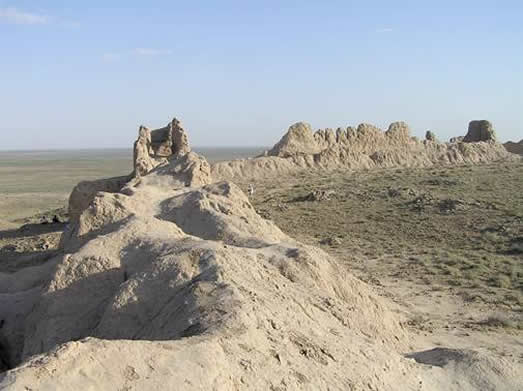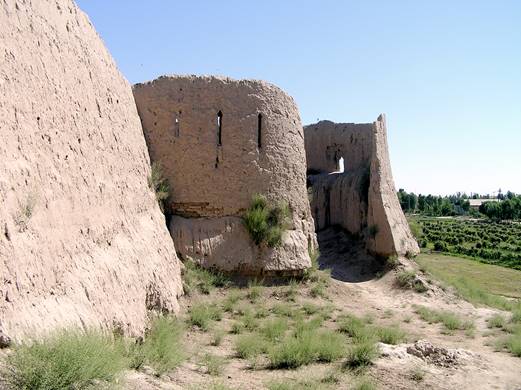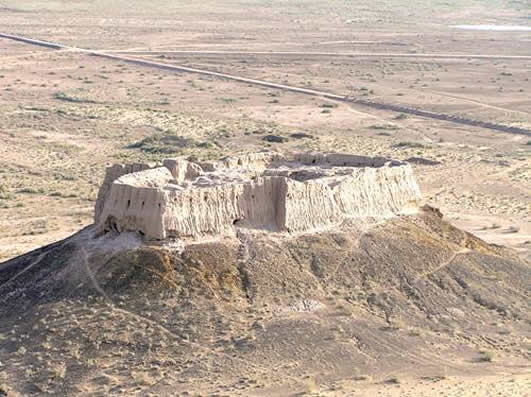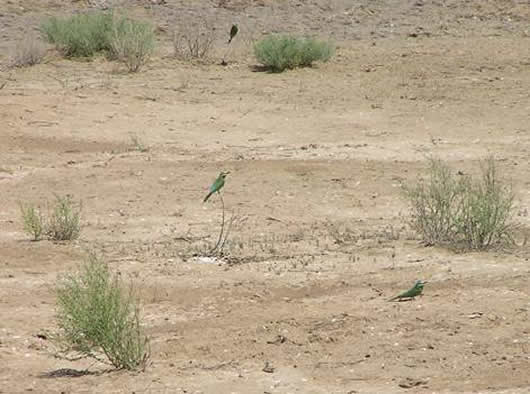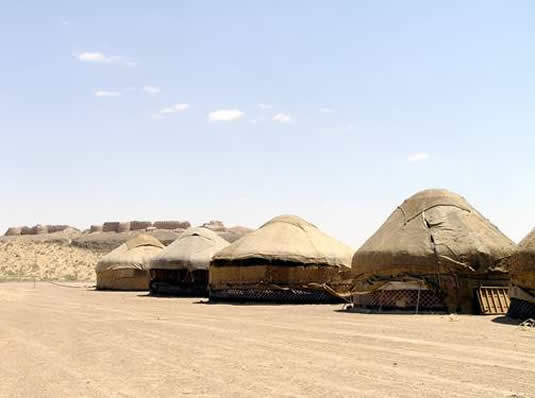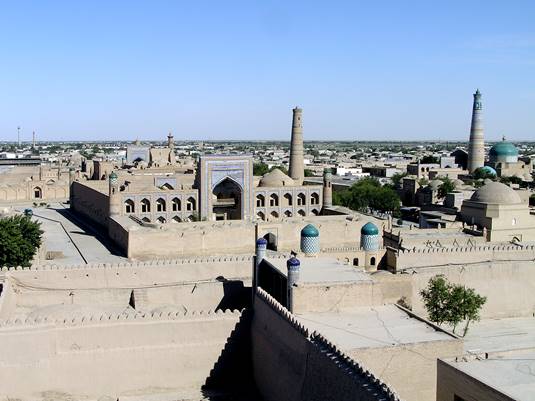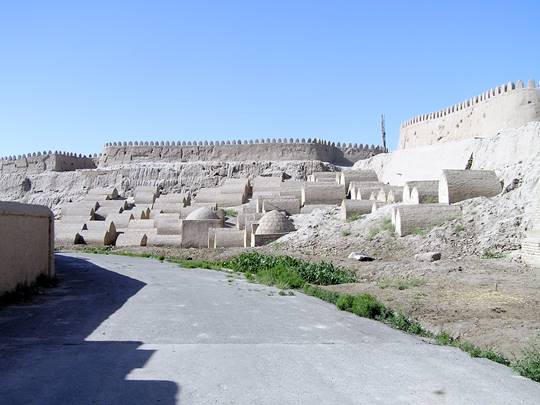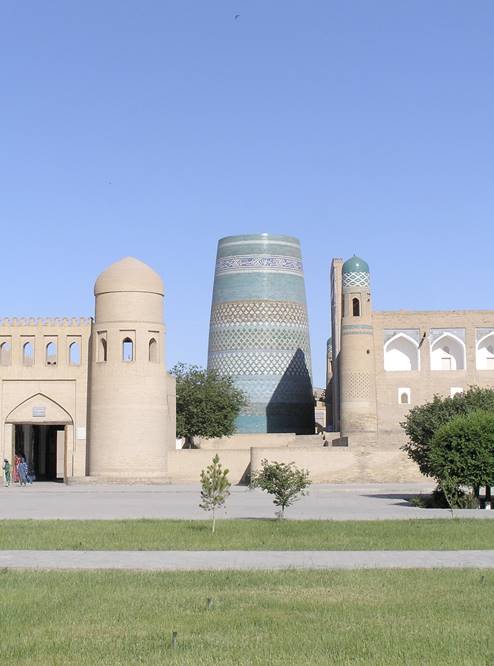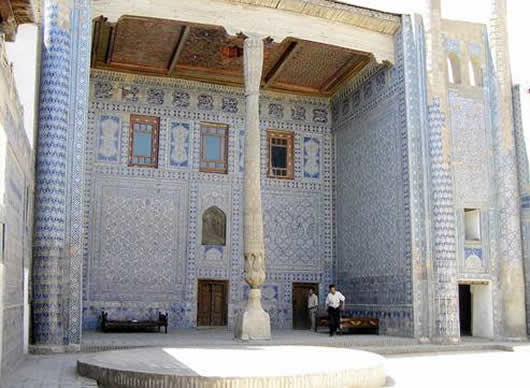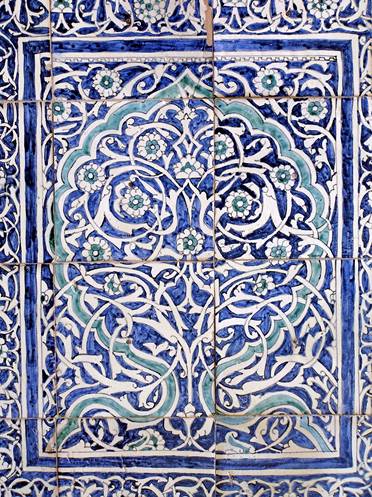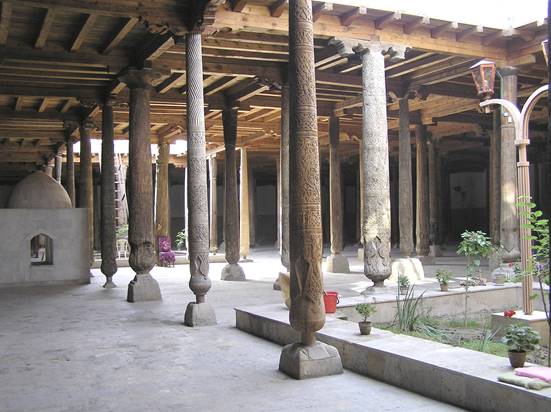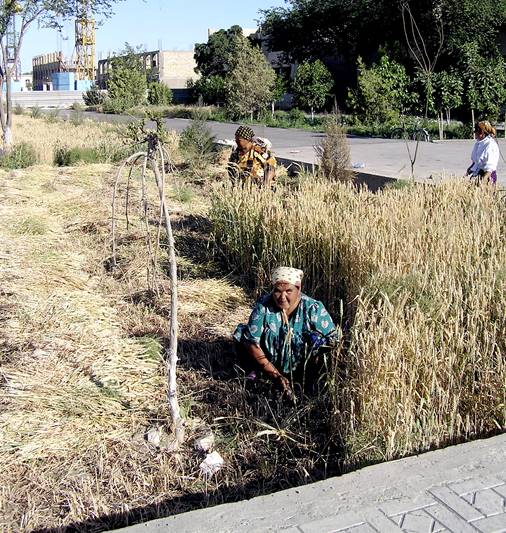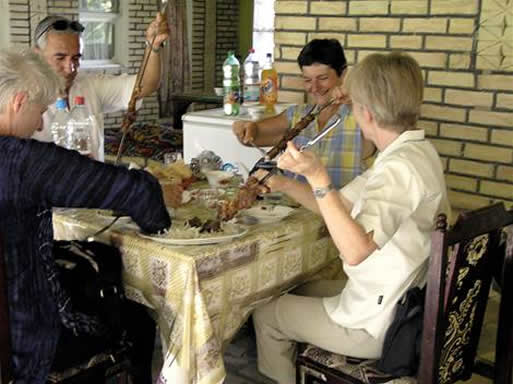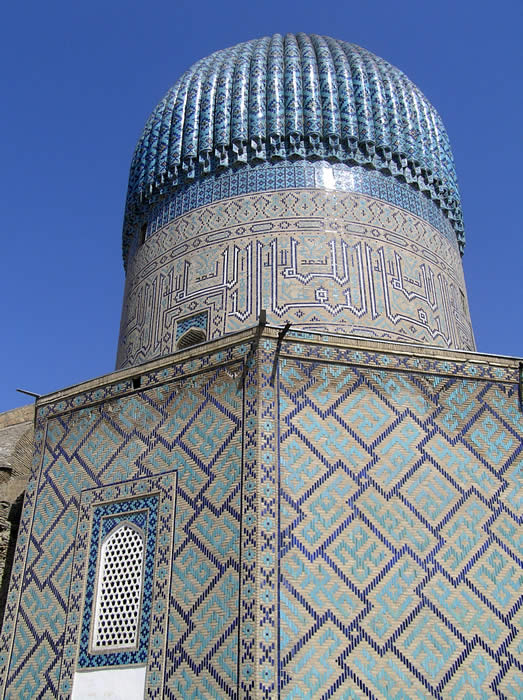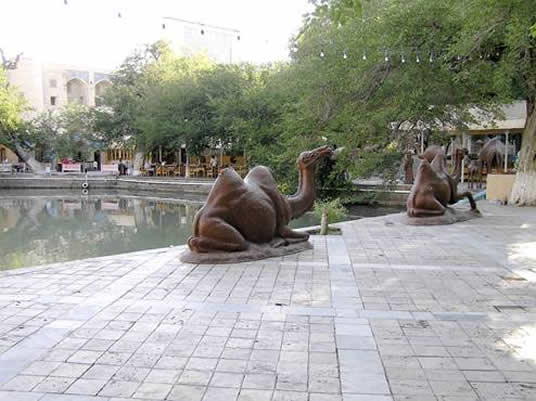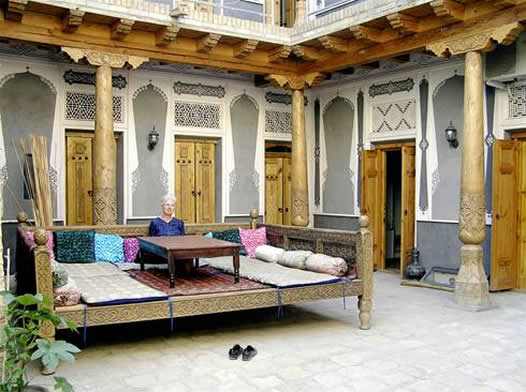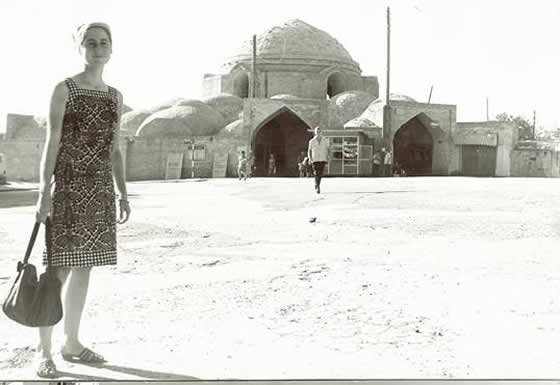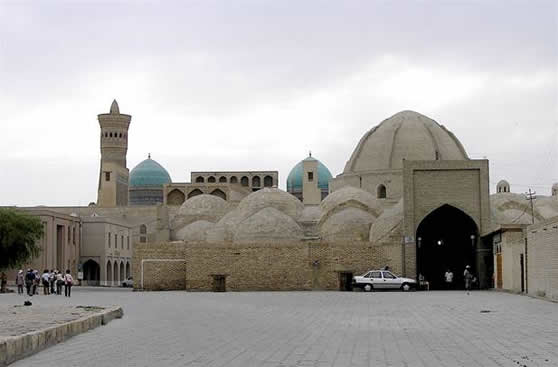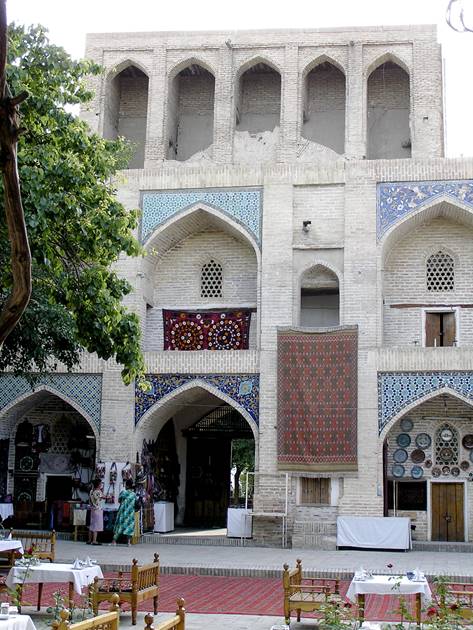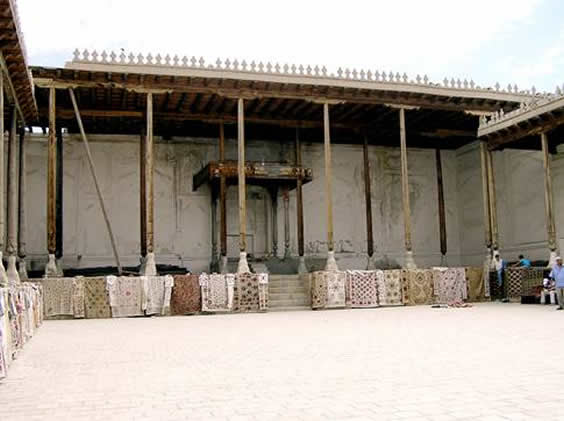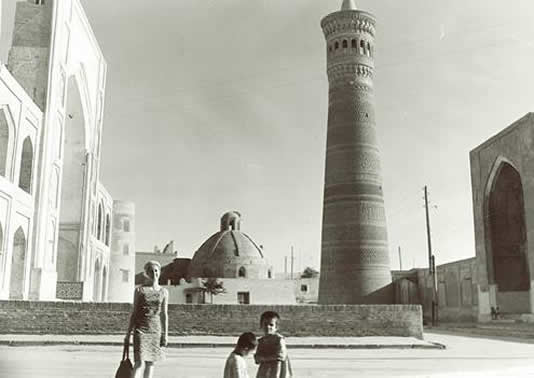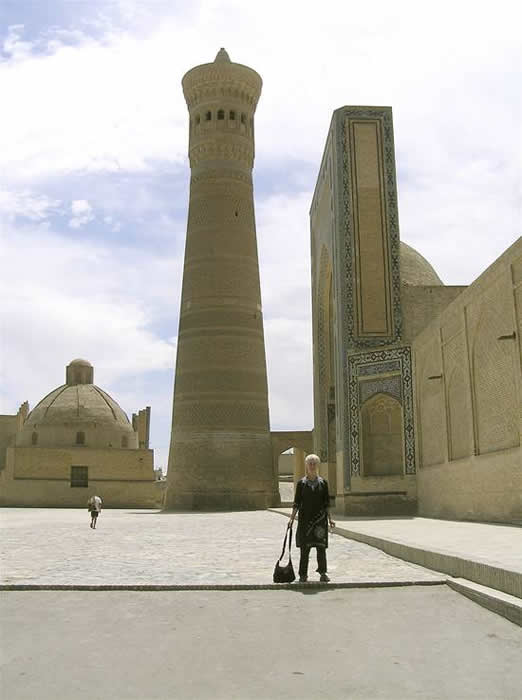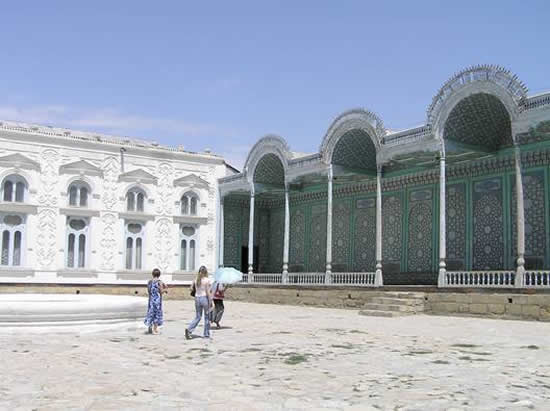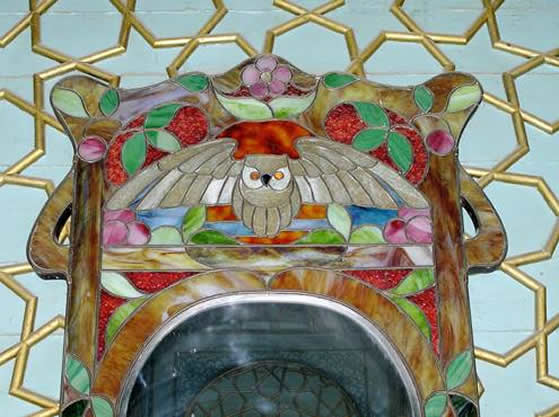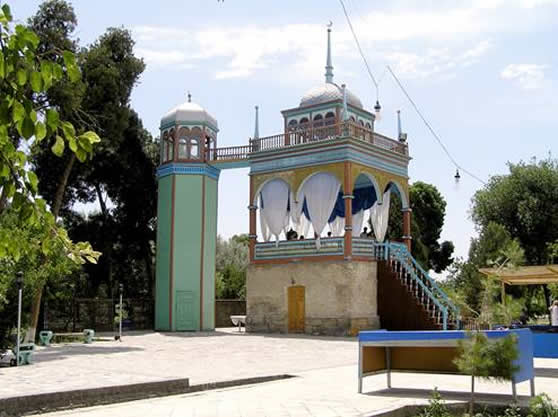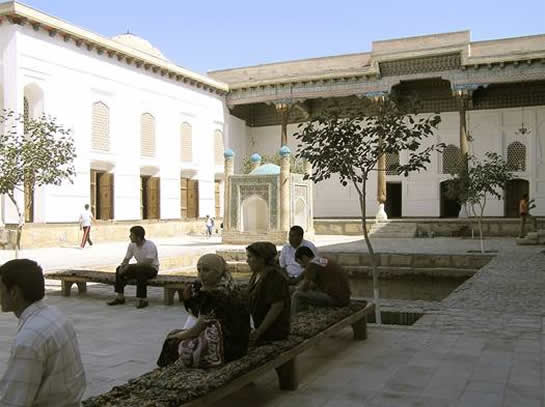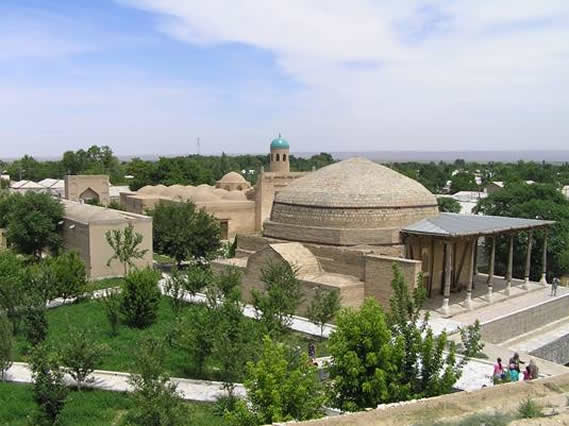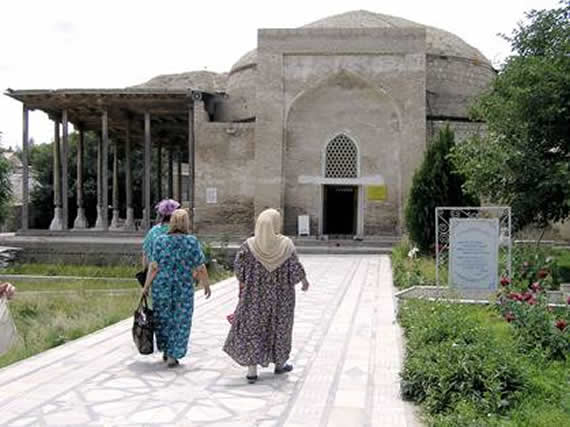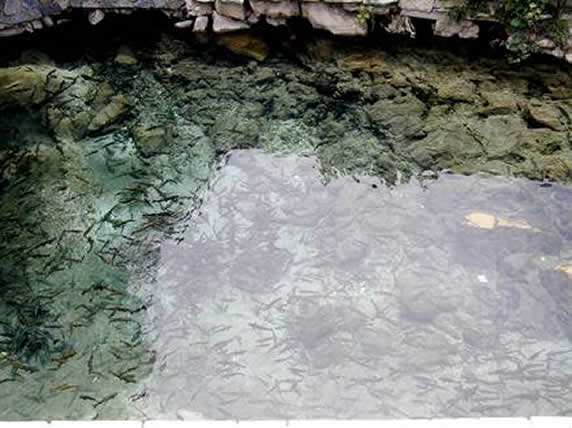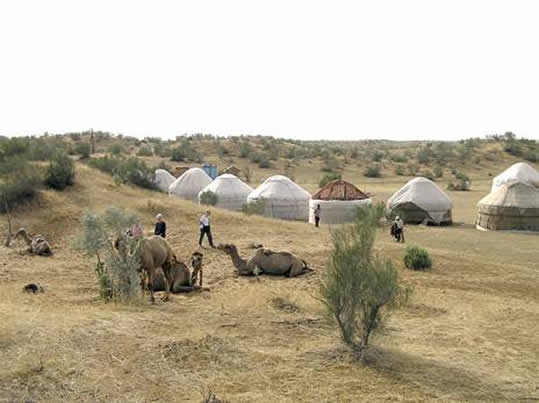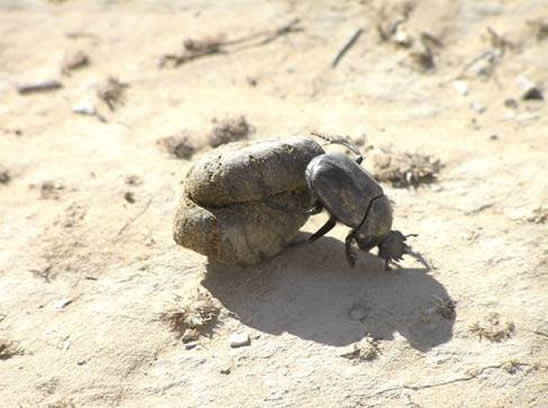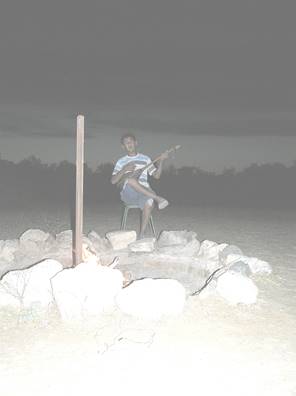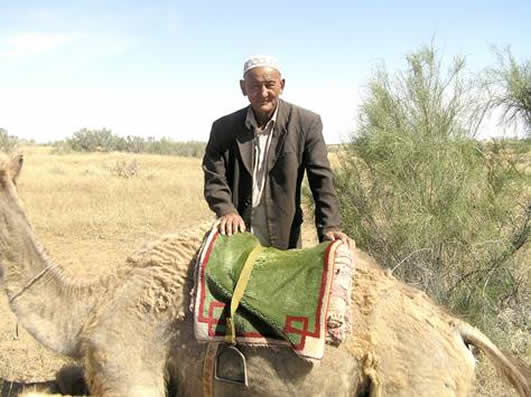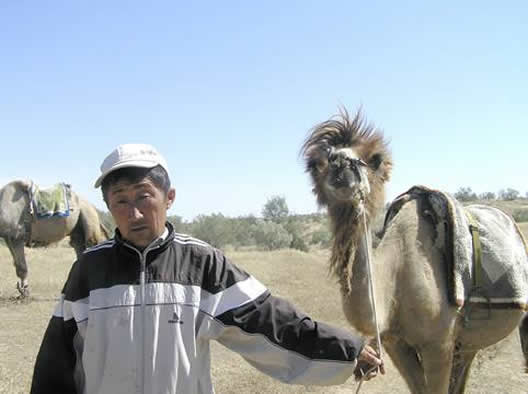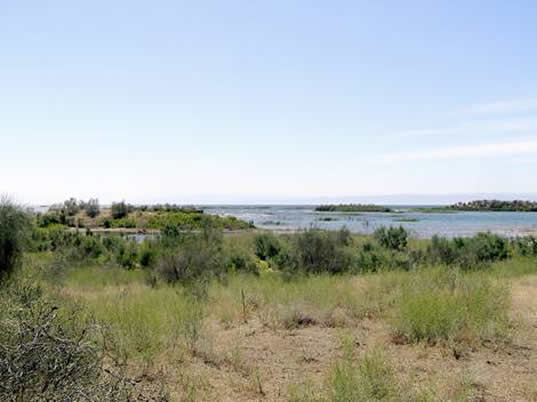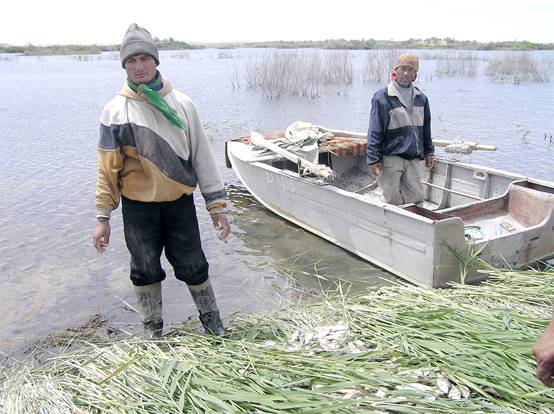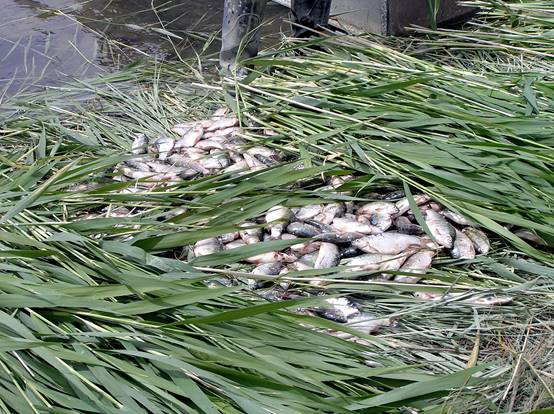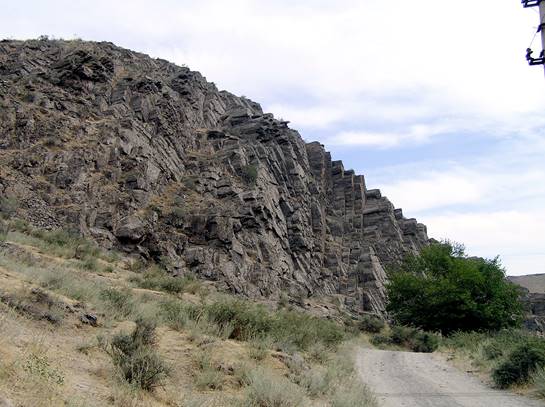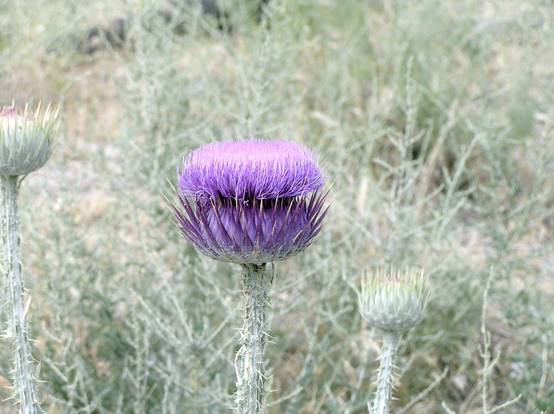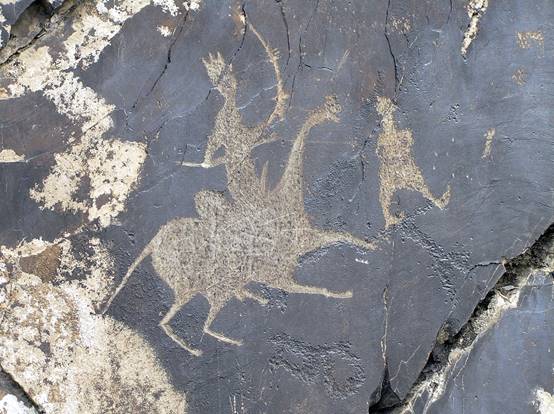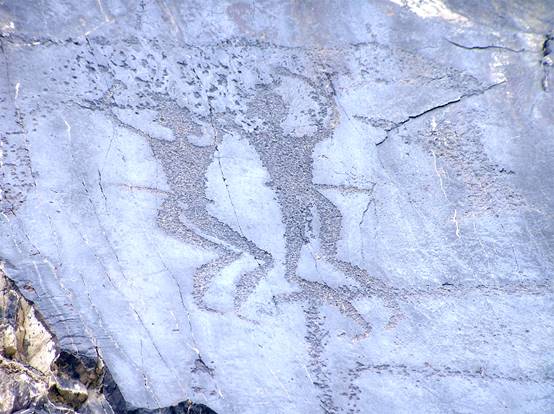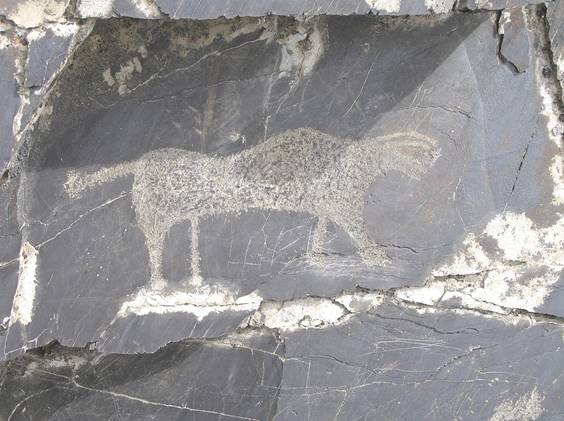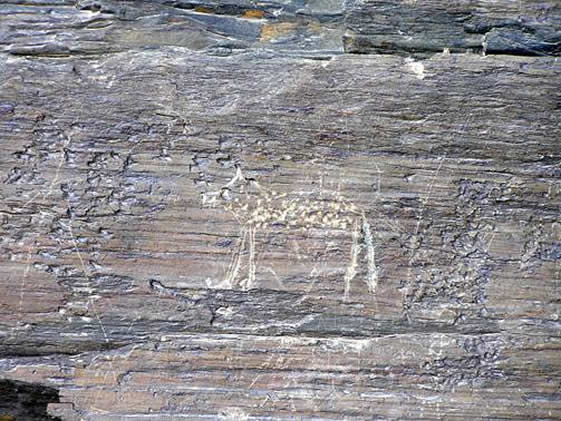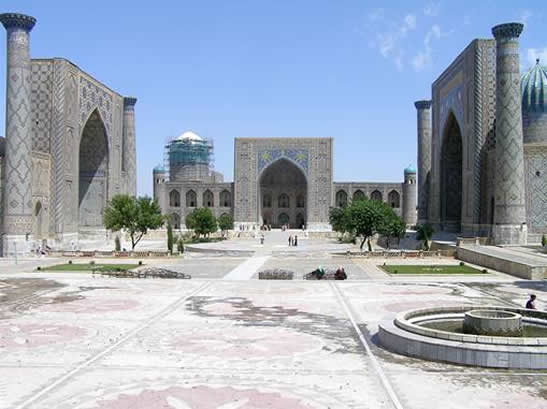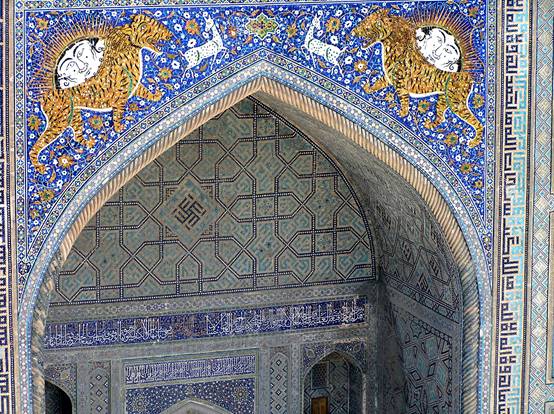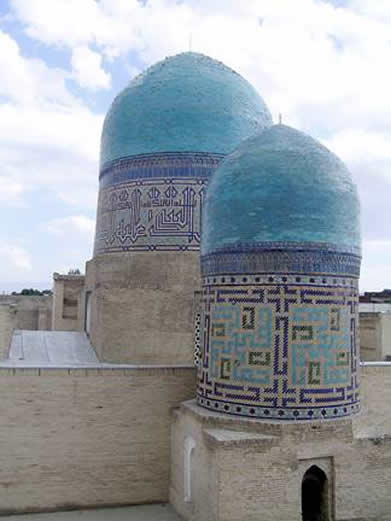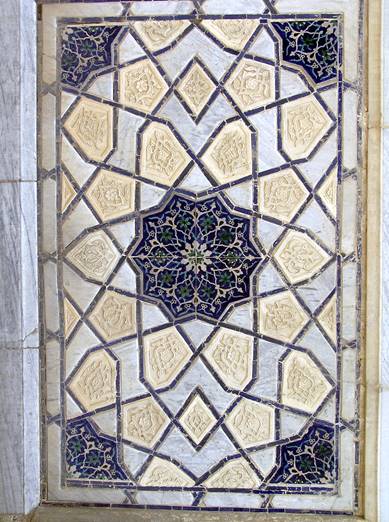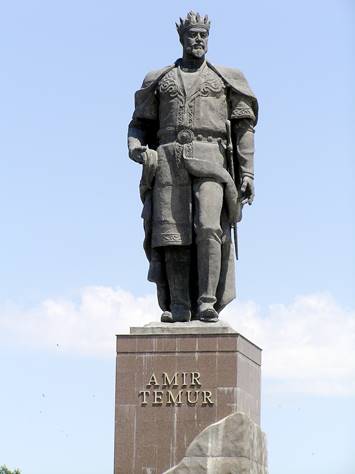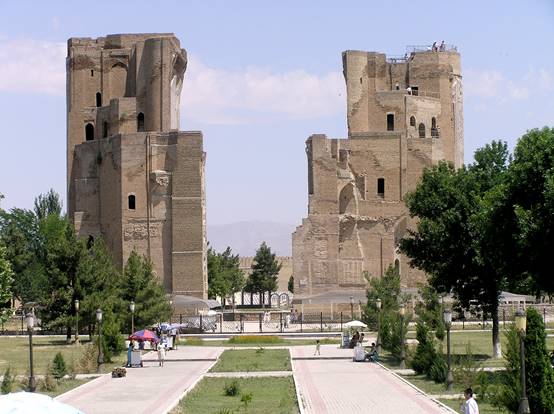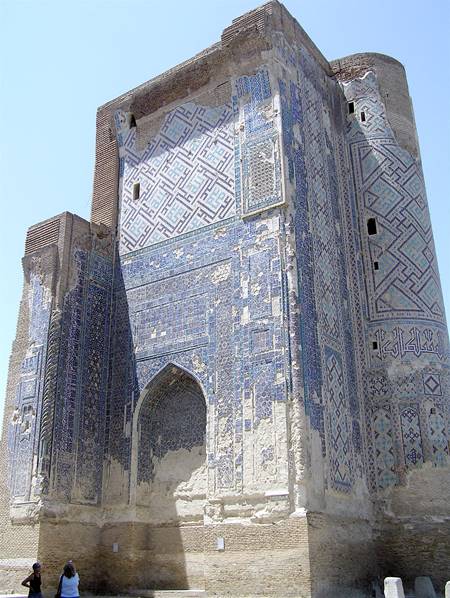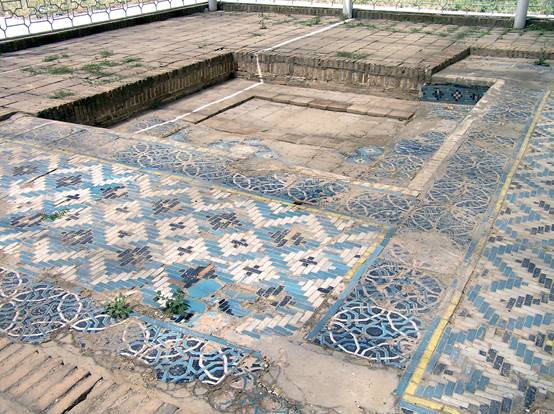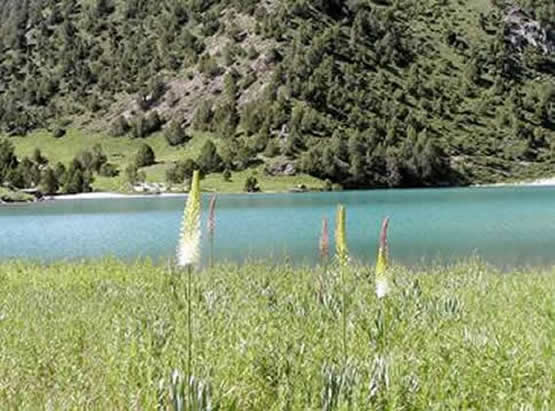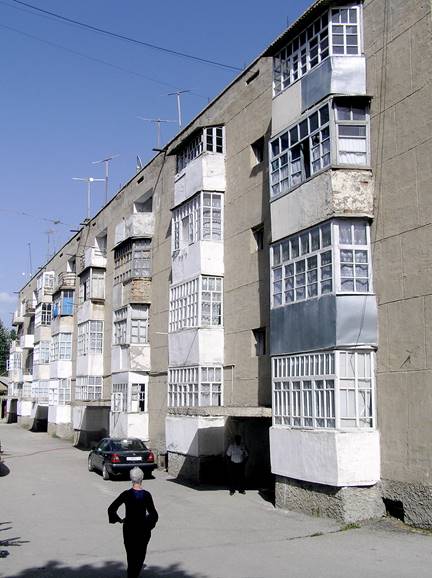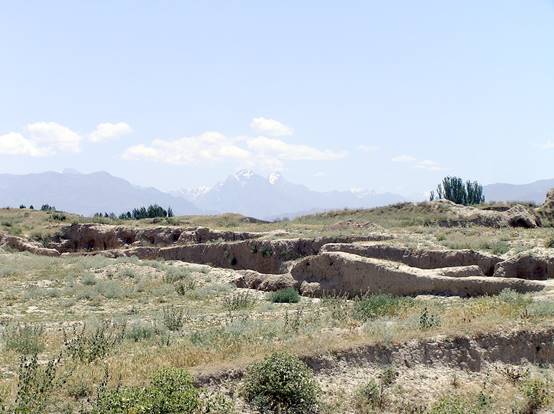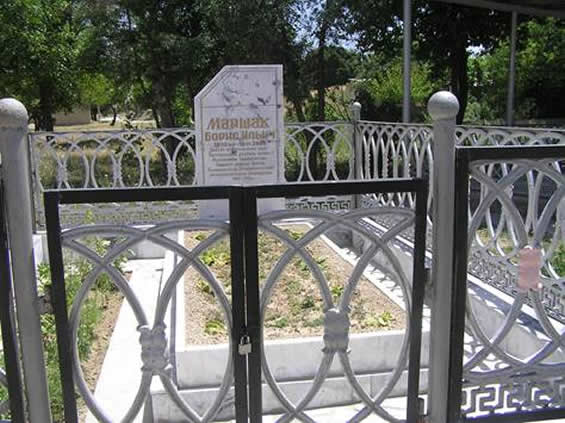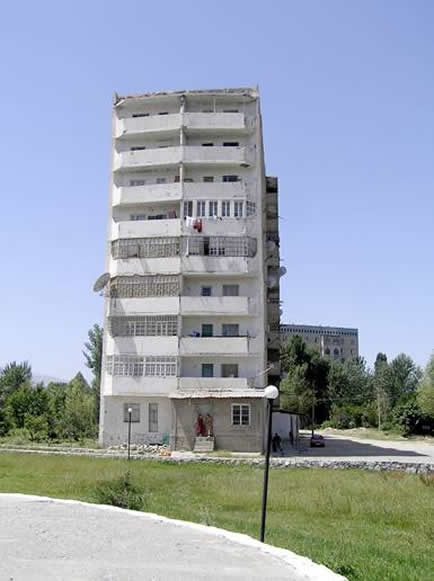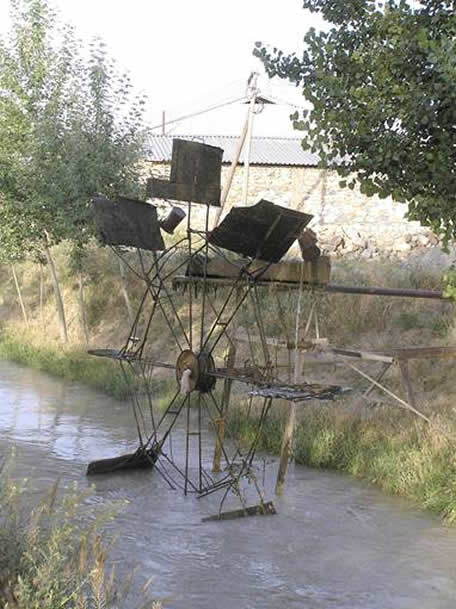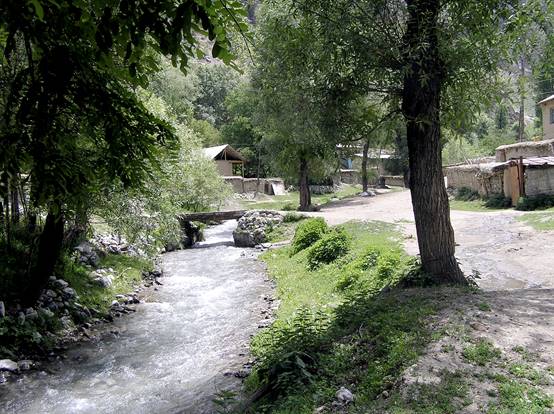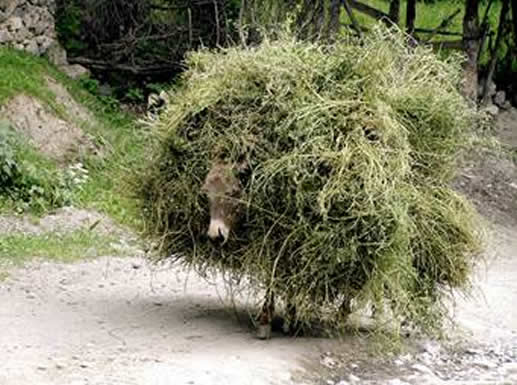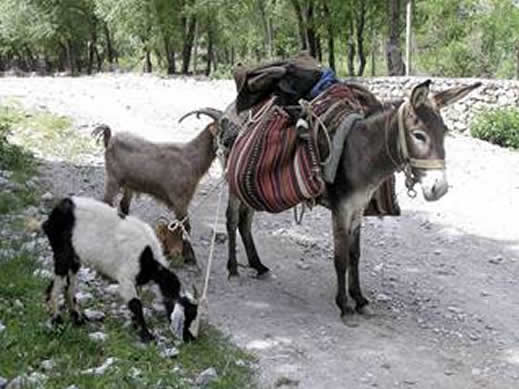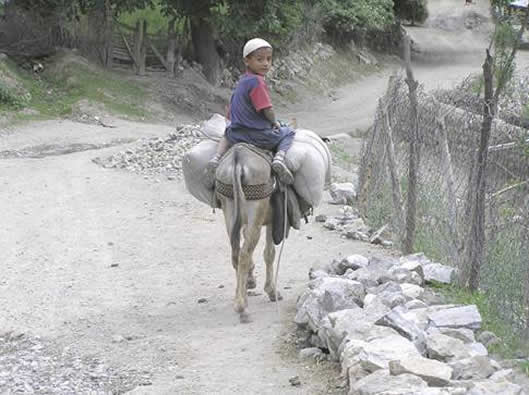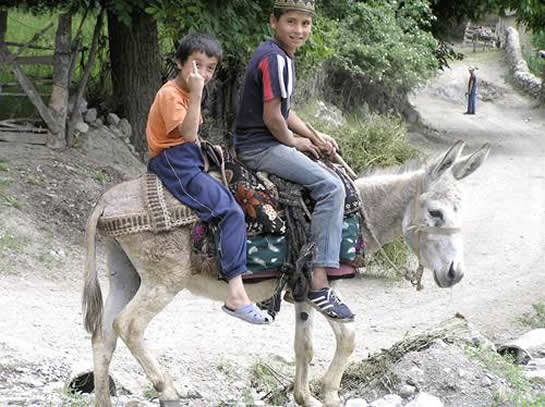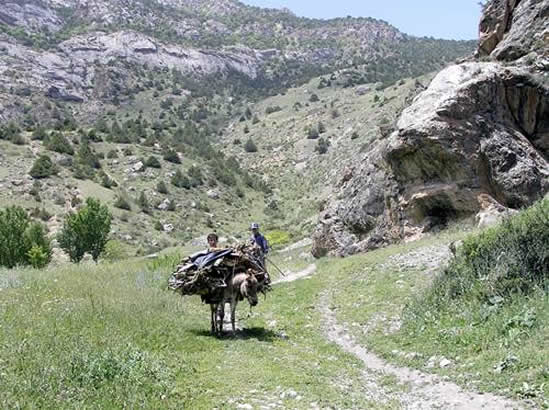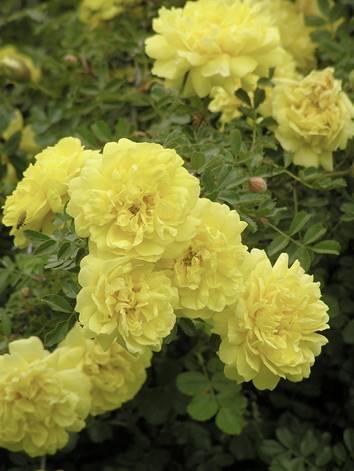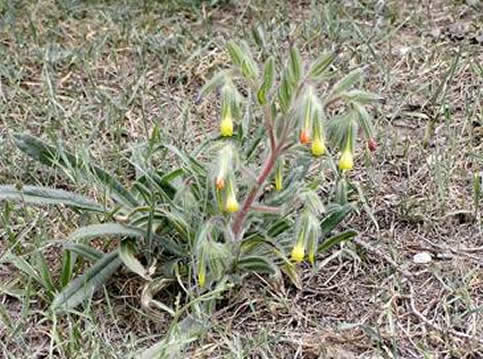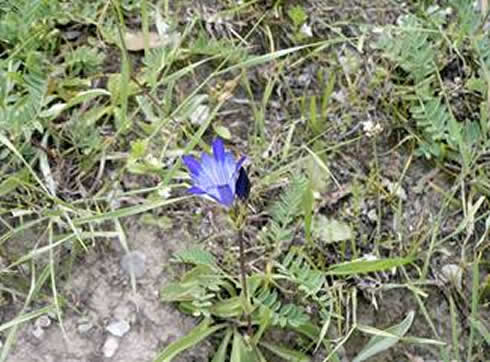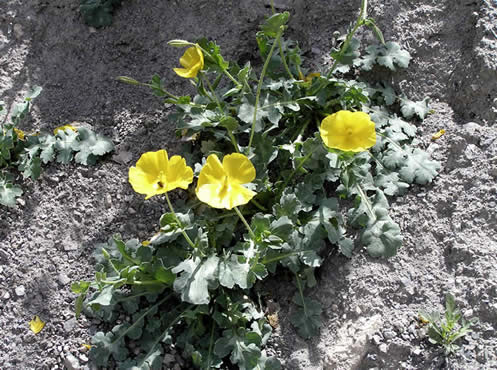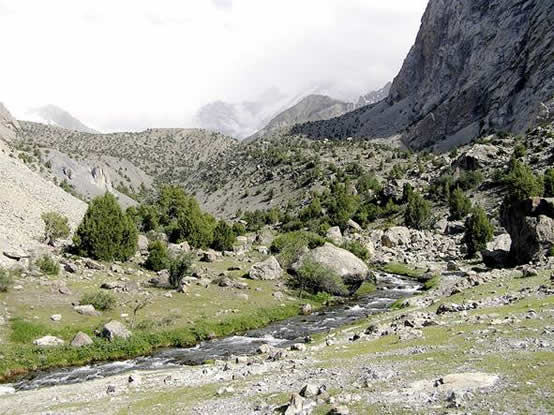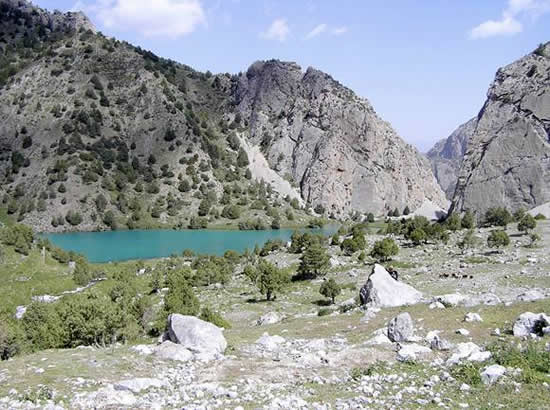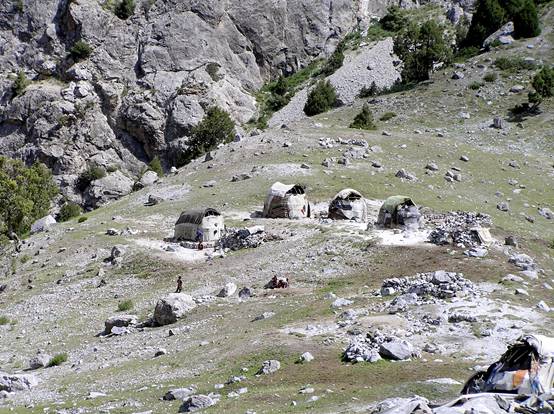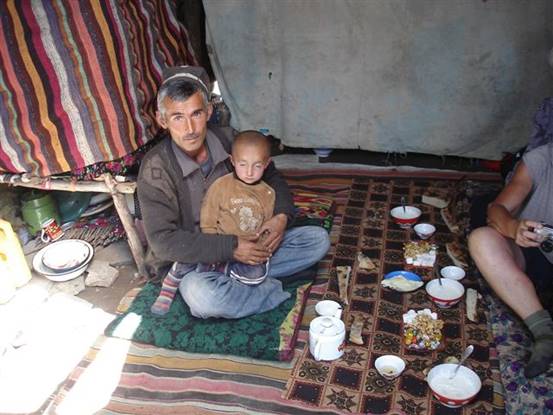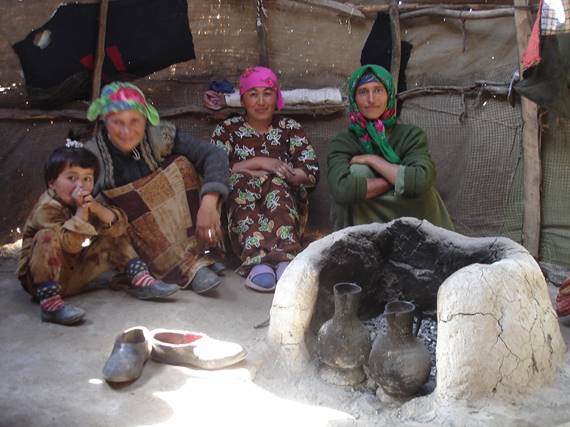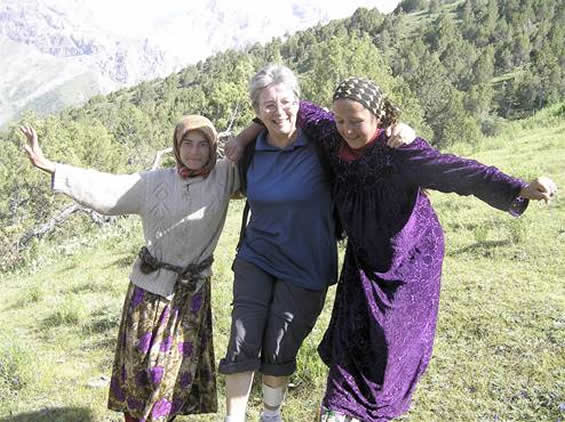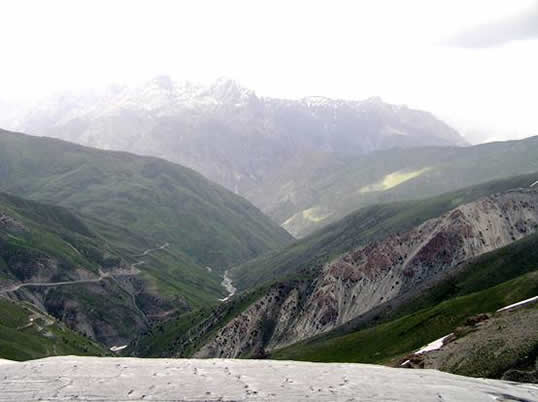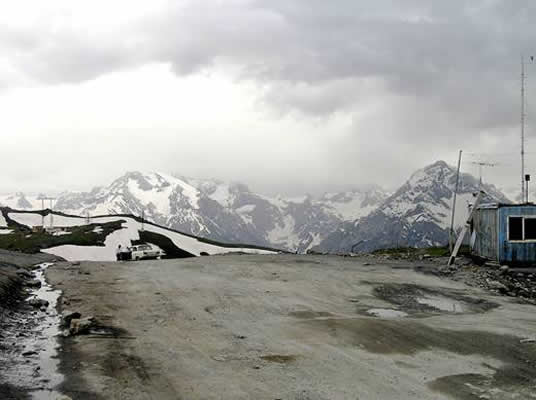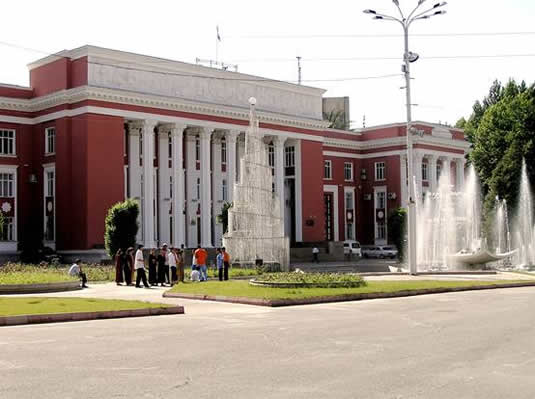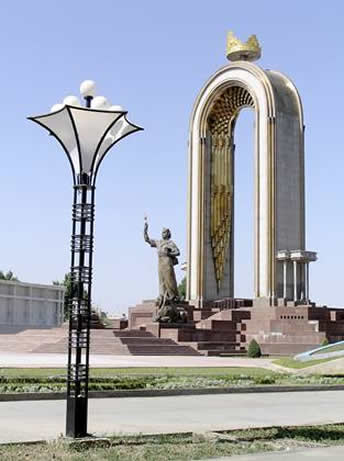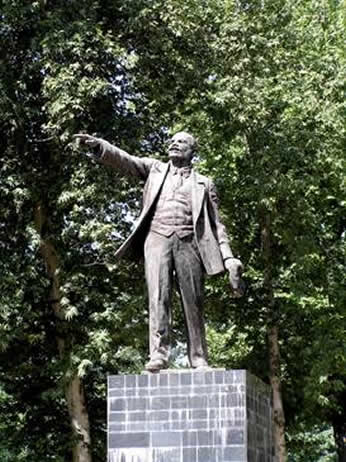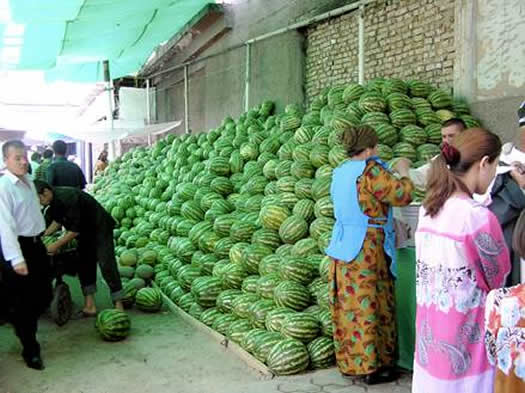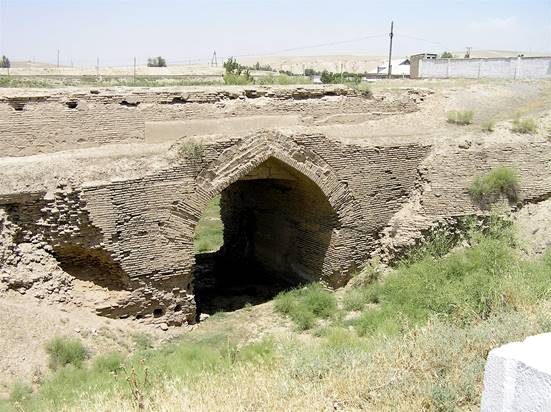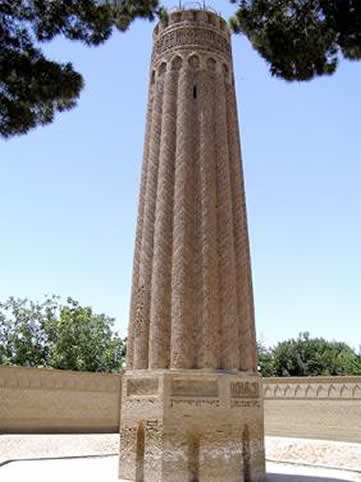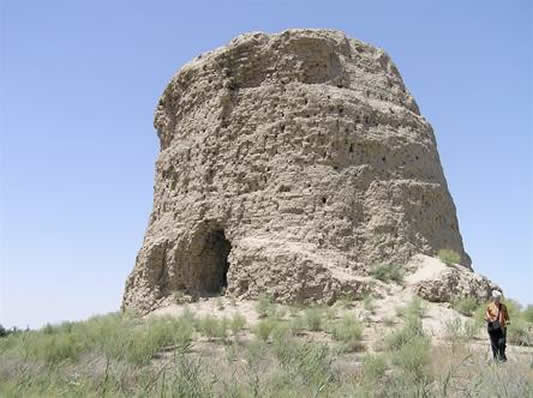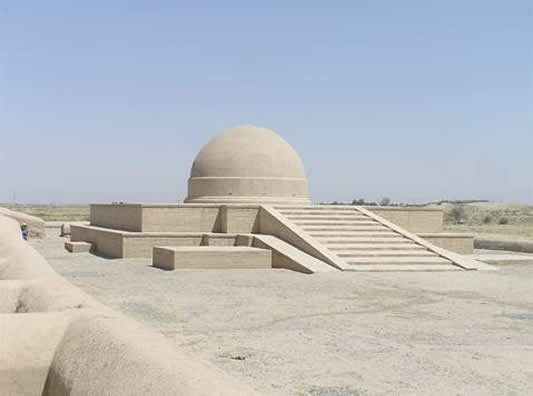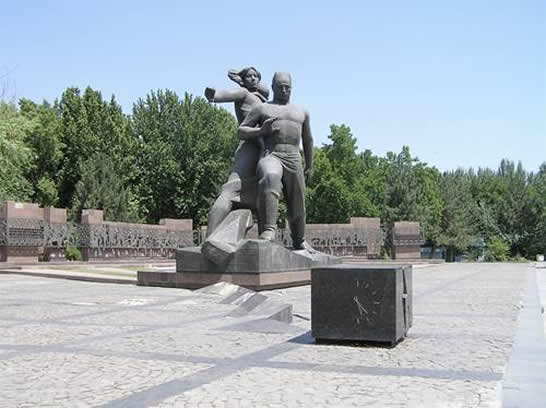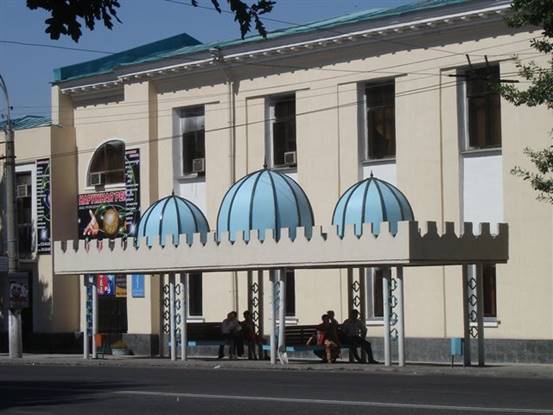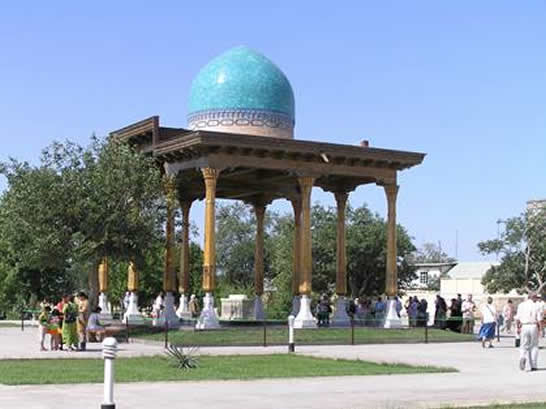THE FOUR LADIES’ TRIP TO CENTRAL ASIA MAY-JUNE 2007
Being an account of a journey through Turkmenistan, Uzbekistan and Tajikistan by Jenny Bacon, Sophia Lambert, Kathryn Morton and Dinah Nichols, all retired senior civil servants.
When we went to China last year, we travelled almost everywhere by public transport – local train or bus – and we did not have the services of a guide. For our trip to Central Asia, with its more exiguous transport network, we were persuaded by our travel agent to rely on hired minibuses with drivers, especially as we wished to go to all sorts of out-of-the way places. An English-speaking guide was imposed upon us in Turkmenistan and we also had one for the mountains in Tajikistan.
Dinah joined us only in Bukhara, and Kathryn left us in Samarkand to fly back to London where she had engagements. So for most of the trip there were only three of us. Our hotels were booked in advance. We booked two double rooms, taking it in turns to share according to an ingenious rota worked out by Jenny to ensure that we all had an equal number of nights alone.
Our chief aim was to visit silk road sites, but we also made a point of visiting any other interesting place that was not too far off our route and we added a couple of days trekking in the mountains of Tajikistan.
What follows does not say much about the major sites, as they are well described in various guidebooks. The photographs were taken by Jenny except where otherwise stated.
Central Asia: a potted history
The area lies between the Caspian Sea and the Pamir mountains that form the formidable frontier with China. It is watered by two famous rivers, the Oxus (now the Amu Darya) and the Jaxartes (now the Syr Darya) and a third called the Zarafshan. Away from the rivers, it consists almost entirely of deserts and (in Tajikistan) of mountains. The cities that made their living from silk road caravans needed a source of food, so they grew up in the oases near the rivers. Many of these cities developed sophisticated civilisations. They were always under threat from nomad incursions from the desert, invasions by their neighbours or from changes in the course of the local rivers. So there was a constant churning of cities and dynasties. There were, however, a few really big players who left a lasting imprint on the area.
The first was Alexander the Great, who conquered most of the area in the 4th century BC. Although he did not stay long, hellenism proved a lasting influence on the art of Central Asia. Following him, the Parthians and then the Persians controlled large parts of the area and the Turks were also active. In the 7th century the Arabs came and islamicised the area, though they did not ever really rule the area, and the Turks and Persians remained the main outside influences. Genghis Khan with his Mongol hordes came down from the northern steppes in the thirteenth century, leaving death and destruction in his wake. About a hundred years later came Tamerlane (or Timur the Great as he is now known locally; Tamerlane is a corruption of “Timur the Lame” and references to his lameness are now frowned upon), from the same Turkic-speaking nomad group. He also brought death and destruction, but in his own back yard of Samarkand and its surrounding area was responsible for many fine buildings and a flowering of the arts. After that, with the withering of the overland trade routes as goods were increasingly transported by sea, there were centuries of small khanates. In the 19th century, the area attracted serious Russian interest, giving rise to the Great Game, and from then on Russia was the dominant power. After the Russian Revolution the area was divided into the five current states and incorporated into the Soviet Union. In 1991, although the populations had voted massively against leaving the Soviet Union (and losing Russian subsidies), Russia foisted independence upon them. Even today, it seems that some people still hanker after Soviet times when every body had a job for life whether they worked or not. Our Turkmen guide quoted one acquaintance harking back nostalgically to the old days “when we could just sit back and eat”.
******************************
A ruined mud-brick silk road fortress
We started in Turkmenistan, a large desert country about the size of Spain, although with a population of only some five million. It lies between the Caspian to the West and the Oxus to the east and to the south has borders with Iran and Afghanistan. Its first president after independence, Niyazov, reinvented himself as “Turkmenbashi”, leader of the Turkmens, on the model of Kemal Ataturk. He developed a strong personality cult, using the country’s substantial oil and gas riches to build many monuments to himself; rebaptising one of the months after himself; and insisting that all schools study his works. He had died unexpectedly about six months before we arrived. Indeed, we feared at one point that we would not be able to go to Turkmenistan as after his death the country was “closed” pending presidential elections. Fortunately, the elections took place without trouble and one of his ex-Ministers has now replaced him.
The population hope that the new leader will moderate some of the absurdities of the previous regime, but during our trip the Turkmenbashi personality cult was still much in evidence. It may well suit the new man to hide behind Turkmenbashi for a while, and it seems that he is already making some small changes, for instance allowing internet cafés to open. At least there was a presidential election, even if all the candidates were from the same party, rather than a takeover by Turkmenbashi’s unpopular son. The latter is said in the bazaars to be under virtual house arrest, as he is supposed to have millions stashed away in foreign bank accounts and the government won’t let him leave the country until he reveals where these bank accounts are and returns the money.
The last British Ambassador here had the good sense to devote a large part of his time to writing an excellent guide-book to the country, published just before we left, and that was a godsend. Our guide in Turkmenistan, who told us that he was once stuck in a sandstorm with the aforesaid Ambassador, said that the latter spent his time criss-crossing the country and ended up by knowing it much better than any Turkmen.
Arrival: 20 May 2007
We arrived at Ashgabat, the capital of Turkmenistan, in the middle of the night. The airport was an impressive example of work creation. Many layers of officials stood between us and the exit, each determined to copy out our passport and other details into huge handwritten ledgers – although to do Turkmen modernisation justice, one official had an actual computer and entered our details on-screen. And as we queued between booths, acolytes checked to see that we were holding the right pieces of paper for the next set of officials. Ashgabat is also the only airport where anybody has bothered to X-ray my luggage on the way out. As we were on full tourist visas, we were obliged to have a guide throughout our time in Turkmenistan, and when we finally emerged on the other side of the barrier we were met by the amiable Jabbar, together with minibus and driver.
Talkuchka Market
Off to our hotel for a brief kip and then to the local Sunday Market at Talkuchka on the outskirts of the city. It was a huge affair spread over an immense area, but not up to Kashgar, according to my companions who were there last year. The livestock market, the best bit, was almost over by the time we arrived, but still fascinating – with sheep, goats, cows and camels. The sheep ranged from black Astrakhan lambs in their old-lady fur coats through to extraordinary fat-bottomed sheep, the huge lumps of fat on their rumps wobbling as they moved. This fat is much prized; we met it later as chunks on kebabs or chopped into tiny pieces in soups to give them body (it is soft like bone-marrow and really rather nice). There were also cashmere goats, but according to our guide virtually worthless as the government has decided that cashmere need not be exported as there is plenty of oil to earn foreign exchange.
Fat-bottomed sheep at Talkuchka market
The camels (dromedaries) had all been sold and were being dragged by their back legs, kicking and (literally) screaming, on to open-backed trucks, all on top of each other so the trucks were heaving masses of legs and necks. The purchasers were herdsmen in from the desert, most now wearing the global male attire of trainers, jeans and T-shirts, but a few still with the huge shaggy sheepskin hats and leather boots that were the traditional Turkmen costume.
Camel with herdsman at Talkuchka market
Camels on a lorry at Takulchka market
Merv and Gonur: 20-22 May 2007
Merv
After the market, we were packed back into our minibus and whisked off to Merv, founded by the Persian Achaemenid dynasty in about 500 BC and one of the great cities of the silk road from the 8th to the 13th century. But it was demolished with extreme thoroughness by Genghis Khan, and all that remains now are the lumpy remains of crumbling mud-brick walls, identical in colour to the surrounding desert, that we grew to know so well from our trips to similar ruined silk road cities in China. Merv was on the Oxus, still a large river that we crossed twice on our travels by somewhat alarming bridges – one was a railway bridge used by cars when there was no train, and the other a series of extraordinarily rickety pontoons that looked as though they would be born away by the slightest storm.
Looking out over the Oxus or Amu Darya
Merv’s latest incarnation is the boring modern city nearby called Mary, where we stayed in one of the country’s few family-run hotels. Called the Caravan Hotel, it was in a private house built round a courtyard – the same type of courtyard house that is standard from North Africa to China. The outer walls of such houses are built traditionally of unfired mud-brick, windowless and blind. One enters through a close-fitting wooden or metal door into a courtyard in which – at least during the summer months – all family life takes place. Some of the courtyards are huge and contain large kitchen gardens or even a few crops. Almost all contain at least a fruit tree or two and some greenery. As one enters from the noisy, parched and dusty street into the unexpected leafy calm, one understands why the Koran so often describes paradise in terms of gardens. Quite often (though not in our hotel), the animals are stabled along one side, with the family quarters and storage areas arranged around the other sides. In honour of its status as a hotel, in our building the owner had installed two shower-rooms with sit-down loos in what were probably the old storage areas. Given the uncertain plumbing, these were not places in which one was tempted to linger.
For dinner we made our way to an open air café in town where kebabs (which go by their Russian name of shashlik) were being grilled and had the first of what was to become our standard meal of shashlik, bread, tomato and cucumber, of which we grew thoroughly fed up (except perhaps for Jenny who is a dedicated carnivore). The shashlik could sometimes be varied with noodles or soup, always with a quotient of lumps of fatty and gristly meat, but we soon discovered that if we wanted vegetables, it was tomato and cucumber or nothing – I don’t think we had more than half a dozen meals with another vegetable during the entire five weeks. The shashliks were mainly lamb or beef, but pork was also available in both Turkmenistan and Uzbekistan and seemingly freely eaten by most Muslims, a result of the long Russian dominance. Our 50-something driver in Uzbekistan described how young men doing their national service in the Soviet army were fed pork; on the first day they did not eat it; nor did they on the second day; but by the third all compunction had gone. Now only the “whitebeards” did not eat pork.
Beer is also freely available, and although Islam is now the official religion, it clearly sits extremely lightly on the average Turkmen. No doubt this is partly due to the determined anti-religious policies of the Soviet authorities. We were told that the President also shut down all the mini-madrassas (religious schools) that sprung up with foreign Islamic support after independence, fearful of nefarious influences. But I suspect that the Turkmens, being nomads, never really adopted the more authoritarian aspects of Islam. None of the women were remotely veiled. They are the Parisiennes of Central Asia, clad in extraordinarily elegant caftans in bright and attractive colours with braiding round the neck. In the villages, the caftans are loose with sleeves at least to the elbow, but in the towns they are tailored to show off the figure and in summer the sleeves are well above the elbow. Married women in the less sophisticated areas wear headscarfs, but tiny ones tied behind the head Russian-style – no nonsense here about not showing the neck and ears.
There are very few mosques, but a strong Sufic influence in the past has given the Sunni Turkmens a strange passion for shrines. The latter are usually based on the graves of holy men, around which handsome mausolea have been built. The shrines receive a steady stream of pilgrims and still show many signs of Zoroastrianism, the pre-Islamic religion in these parts. There is usually a sacred tree on which wish-rags are tied; childless women tie miniscule cloth cradles between two branches. Often, tiny constructions of three stones set in a triangle (representing the Zoroastrian trio of fire, earth and water) have been built by pilgrims on the ground next to the mausoleum. Our guide told us that a lamb is still sometimes sacrificed today when a person has a problem or a difficult decision, with friends and relations then being sensibly invited round to eat it afterwards. I asked to which God the sacrifice was made – Allah or some old Zoroastrian god. The answer was that people were somewhat vague about the precise identity of God; people thought in terms of “the way of God”.
Mausoleum of the Seljuk ruler, Ahmed Sanjar, built in 1157, near Merv
Mausoleum of Ahmad Sanjar, internal decoration
Sacred tree with wish-rags near Merv
Gonur
Not far from Merv, a much earlier bronze age site called Gonur has been excavated, and we were taken along a bumpy track to visit this site, not normally on the tourist itinerary, joining forces with a young diplomat from the German Embassy in Ashgabat and his American wife (gosh, her life sounded boring – coffee mornings and bridge). The archaeologist in charge, a Russianised Greek called Victor Sarianidi, has been working there since 1972 and is one of the grand old men of Central Asian archaeology (it was he who excavated the Afghan gold that we saw at the exhibition at the Musée Guimet in Paris last year). He was on site, looking the part with a magnificent leonine head, and we were sat down and given what was clearly the signal honour of being able to ask him questions. Jenny with her archaeological training was invaluable in keeping our end up; the young German diplomat was useless.
Front row: Victor Sarianidi and our guide Jabbar; back row: Kathryn on left, Sophia second from right.
Gonur dates back to before 1,000 BC, and was abandoned when the local river changed course. It is a huge site, beautifully excavated. As in the later silk road cities, the buildings were built of sun-dried mud and straw bricks. Protecting the friable remains of these cities from the elements is a major challenge for the archaeologist, both here and in China. At Gonur, having uncovered the walls, the local archaeologists then plastered them over with a protective layer made of the same mud as the bricks, so one could still see the shape of the walls and the buildings – a good solution, even if it did not convey quite the same air of romance as the visibly crumbling ruins of the average silk road city. Lots of potsherds still littered the site, and every so often an amphora for storing grain had been left in the ground where it had been found. Where the main kiln had been, there were strange bits of glassy green rock where the heat had been enough to vitrify the stone all those years ago.
The site at Gonur
Victor Sarianidi had developed a fascinating theory that the religion of the inhabitants was proto-Zoroastrianism. The ruins contained strange double hearths apparently for fire sacrifices so that the lamb being sacrificed could be cooked without being adulterated by – or adulterating – the fire. This proto-Zoroastrianism also involved the concoction of a ritual drink, soma, the precise ingredients of which remain mysterious although clearly narcotic. Traces of soma were found on the site, and we were told that analysis revealed a potent mix of cannabis, poppy and ephedrine. Carvings and clay models found at the site show the dilated eyes of the consumers, and at one place near the main temple there were a series of coffin shaped compartments in the ground, possibly for the priests to sleep off the effects of the drug – they reminded me a bit of those drawer-like cubicles at Japanese station hotels in which drunken businessmen are put to spend the night while they sober up. We also saw some strange graves, belonging to a horse or donkey and three sheep, their skeletons still in situ. They had been buried ceremoniously with grave goods like VIPs – nobody knows why.
Proto-Zoroastrian double hearths at Gonur
Beds for stoned Zoroastrians to sleep off the effects of the sacred drug?
Serakhs: 22-23 May 2007
Our next stop, Serakhs, was a sleepy frontier town on the Iranian border not far from Mashshad. We had asked to go there to see the ruins of old Serakhs, an important silk road town between Nishapur and Merv whose heyday was in the 12th century under the Seljuk Turks. Because of its position, it is in a “closed zone” and all sorts of extra permissions had to be obtained to get us there. At the last moment it was discovered that our driver did not have the right permit and another driver had to be rustled up – altogether we had half a dozen different drivers during our week in Turkmenistan. The Turkmen driver who picked us up at the airport had been sacked by the next morning because of a spat with the guide, and replaced by the tall, dark and handsome half-Russian half-Central Asian Timur, the one who to our regret did not have the permit for Serakhs. He was replaced by a dour Turkmen called Murat, who was then replaced in Ashgabat by the aggressively blond Russian Volodya, who was joined for the trip across the Kara Kum desert by the equally Russian Sasha. Yet another Turkmen driver then took over for the drive to the Uzbek border, as neither of the Russians had the right permit for that border area.
All the main roads in the country (and also in Uzbekistan and Tadjikistan) have police/internal customs check-points at regular intervals, a legacy of Soviet times. Mostly these are staffed by bored uniformed youngsters who only occasionally stop a car or truck to relieve their boredom. But the check-point at the entry to the Serakhs area took us very seriously. Endless telephone calls were made to higher authority before we were finally allowed through as nobody wanted to take responsibility for the decision. The town itself is a dump of a place. It has a German colony sent here by Stalin during the Second World War and a large Iranian population – apparently the frontier was drawn through Serakhs province at a Moscow tea-party between the Shah and Stalin, leaving a lot of Iranians on the Soviet side who show no hurry today to return to black-chadored and alcohol-free Iran. A local Turkmen told us that the Germans were more friendly – “when four Turkmens and two Iranians meet for a meal, the Iranians speak Iranian”, whereas the Germans would speak Turkmen.
There are no hotels, so we were accommodated in the house of the head of the local archaeological mission. His house doubles as the headquarters of the dig was very basic, built around a big courtyard. We slept in two dormitory-type rooms normally used by people working on the dig, each with four truckle beds and not much else except a hideous chandelier ceiling light. Next door was room with a table where we were given our meals and which was the only place to sit when not in bed. On the far side of the courtyard there was a loo and a bathroom. The loo was an earth closet with a beautifully clean dried mud floor and two well polished planks to squat on. A small besom lay next to them, presumably to sweep away anything that missed the hole. The latter was an exceptionally wide one and immensely deep, and I was terrified that my money belt would slip off into it as I squatted. As we found elsewhere, the room itself was thankfully large and airy, so there was very little smell (far removed from those tiny stinking cubicles within which earth closets were confined in southern Mediterranean countries in the 1960s and 1970s).
The bathroom merited that name as it actually had a bath-tub in it. But as we were to find in a number of other places, including private houses, there was no plug and no sign that it was ever used for an actual bath. There was a non-working shower and a long sink-type tap protruding over the bath under which a small person like myself could squat to wash. This passion for unusable bath-tubs mystified me; it would surely be easier to have a simple shower with a drain in the floor, or a tap in the wall with a bucket and stool, as in India. The bathroom had a tiny sauna off it, presumably used by homesick Russian archaeologists in winter.
We were taken first to see the typical archaeologists’ room, full of boxes of shards and digging paraphernalia, to look at some of the finds (although the best have been whisked off to museums) and then to the site itself. The latter was only of moderate interest. Rather tantalisingly, they described but did not take us to their most recent excavations, full of Sassanian (Persian) and Zoroastrian remains.
Ashgabat, 23-24 May 2007
Back to the capital, Ashgabat, which we had yet to see properly. On the way, we stopped at a “fish restaurant”, a cafe by the road-side that served fish from a nearby reservoir. It was deep-fried and very dry, but surprisingly good with the ubiquitous tomato and cucumber and a most welcome interruption from the endless meat kebabs.
I had last been in Ashgabat in August 1966, when it was a dusty town of concrete five-storey Stalinist flats built following the earthquake that had destroyed the place in 1948 (Stalin is supposed to have decreed that no apartment blocks in the Soviet Union should have more than five floors, to avoid the need for lifts). It is now quite unrecognisable – the whole centre is a city of green trees and white marble palaces interspersed with fantastical monuments to the first President and his mother. The latter was killed in the 1948 earthquake and subsequently idealised and idolised by her orphan son.#
A view of Ashgabat in 2007
The palaces house ministries, museums and other official buildings and are mainly neo-classical in style, with huge pillared porticoes. The monuments range from the absurd to the really rather impressive. Into the first category falls the famous Neutrality Arch (to mark Turkmenistan’s “permanent neutrality”), topped by a small golden statue of Turkmenbashi. It is supposed to revolve so that he is always facing the sun – only unfortunately the mechanism has been going too slow or too fast and it is now out by a few hours.
The Arch of Neutrality in Ashgabat with the revolving golden statue of Turkmenbashi on top.
The most impressive monument was the “Earthquake Monument”, built in memory of the 1948 earthquake victims. Turkmen mythology has the earth perched between the horns of a bull; and when the bull moves his head to readjust his load, the result is an earthquake. The dark bronze monument shows a well-endowed bull holding the globe, rent with dramatic fissures out of one of which emerges a small golden boy – representing the child Turkmenbashi surviving the earthquake. This description makes it sound absurd, but it is well and powerfully sculpted.
The earthquake monument in Ashgabat with a golden baby Turkmenbashi emerging unharmed from the quake.
Our hotel was a little way from the centre, on a road down which Turkmenbashi used to drive in to work. He decided at some point that the city needed some more hotels and that this was a good place to put them. So one side of the street consists of a row of hotels, all in generous and well-planted grounds, so as not to be visible one from the other. Each hotel is different in theme and construction; ours was associated with the oil industry and had a “nodding donkey” in the middle of a flowerbed in front of the entrance. The vast atrium was full of marble pillars, grandiose mosaics and particularly vulgar chandeliers. When one looked closely, everything was very slightly tacky, with cheap plastic fittings already warped and broken. Needless to say, as there are so few visitors most of the hotels are empty for months at a time (we seemed to be the only guests in ours). On the other side of “Hotel Street”, blocks of splendiferous white marble flats have been built, but apparently so expensive to rent that they also are mostly empty. The road itself was immensely wide, with three or four lanes on either side, but so few cars that we could wander across with no problem. Indeed, the whole area was as empty as a ghost town.
The nodding donkey outside our hotel in Ashgabat
On the way out of town, old Stalinist blocks still survive and also some more traditional courtyard houses, sometimes incongruously combining a clay tamdyr oven outside or a camel in a stable with a satellite dish on the wall. This was not the only interesting clash of old and new. Neutrality Arch boasted an efficient modern German lift to take visitors up and down. When we pressed the button to summon it to go down, the door immediately opened to reveal a couple of disconsolate and somewhat jungly-looking Turkmen youths, clearly up from their village to see the bright lights. They had got into the lift and the doors had closed behind them, but they had probably never been in a lift before and had no idea which button to press to go down, so they had apparently been standing there patiently waiting for something to happen.
It is quite hard to tell how much of the oil-wealth has trickled down. On the one hand, little seems to have been spent on modernising for instance the health service (although there was no obvious poverty or disease). On the other hand, the main roads at any rate are excellent, and Turkmenbashi decreed that every household could have free gas and electricity (and it costs less than five dollars to fill a 65-litre tank with petrol). While this may prove a wasteful and short-sighted move in the longer term, it presumably must have helped many households in the short-term. There seemed little shortage of reasonably priced electrical equipment. Most houses had a satellite dish – indeed the fronts of some blocks of flats are so covered in them that they look like scales on a fish (we were told that Turkmen TV is so dreadful that everybody has a dish to tune into Russian or Turkish stations).
The main museum was in a huge new building complete with portico and vast be-fountained fore-terrace. The building was alive with uniformed officials and smartly dressed girl attendants, but we seemed to be the only visitors. The staff were bemused by us as they are clearly used only to organised groups, but they finally let us in. The cavernous ground floor is devoted to – guess what – the life and doings of Turkmenbashi. But the next floor has a well-displayed collection of finds from archaeological sites around the country, including Gonur and Serakhs. There are some beautiful things, including some stunning 2nd century BC ivory rhytons, purely hellenic in style.
The next day, at my instigation, we went with our guide to the carpet museum. Turkmen rugs – those busy red ones that we know as Bukhara rugs as that is where they used to be sold – are central to the local culture. The national flag has the carpet patterns from each of the five provinces; and one of new bank holidays proclaimed by Turkmenbashi is National Carpet Day (along with, inter alia, National Melon Day and Holiday of the Turkmen Horse). The museum was interesting. I had never really got my mind round the different patterns of Turkmen rugs and all became much clearer – although unfortunately most of the carpets on display were in hideous chemical dyes, to the disgust of Jabbar, our guide, who has started a business with an Afghan friend making carpets in naturally died wool and silk. The most hideous thing of all was “the largest carpet in the world” on a wall in a vast hangar on one side of the museum. Turkmen carpets, with their small repetitious patterns, are fine when small, but to be faced with a carpet of almost 200 square metres, all in harsh chemical colours, was just too much.
We are now Turkmen TV stars. A TV crew was standing aimlessly about as we went round the museum, and just as we were leaving plucked up the courage to ask to interview us – as we were again the only visitors, they must have been waiting around all morning for somebody to film. It turned out that National Carpet Day was in a few days’ time and was to be marked by an International Carpet Congress in Ashgabat, and the TV crew had been instructed to make a programme for it. As I was the one who knew most about carpets, I was pushed by Jenny and Kathryn before the camera and was interviewed for what seemed to be about 10 minutes, with Jabbar acting as interpreter (and prodding me to put in a plug for natural dyes, which I was only to happy to do). I drew on all my Diplomatic Service background to spout high-sounding stuff about the beauty of Turkmen carpets, the British 100-year love story with them, the marvellousness of the museum, the wonders of modern Turkmenistan etc (the British Embassy would have been proud of me). Jenny and Kathryn, who thought that they had escaped, then found the microphone shoved under their noses and had to find yet more things to say, albeit at less length. I then had to do yet another interview, this time for Turkmen radio, so they certainly got their money’s worth from us. I suspect that it was lucky for them to find some foreign tourists to interview, as tourists are few and far between in this country. Jabbar subsequently told us that his wife had subsequently seen us on telly and had been boasting to all her acquaintances about meeting us.
Jabbar was an interesting guy. His grandfather had been a big man in the Eastern Ersari province of the country, with “three flocks”, each of some thousand sheep and goats, who dominated a large local area with the help of a small private army (not dissimilar, no doubt, to the mini-war-lords still active in North West Pakistan and Afghanistan). The private army was no match, however, for the Soviet forces when they arrived to collectivise the herders of that area. After three members of the family had been killed, Jabbar’s father and grandfather saw the writing on the wall and fled to Afghanistan where there was already a big Turkmen minority. Jabbar was brought up there and trained as a doctor, subsequently going to work in Pakistan. When Turkmenistan became independent, he was one of quite a number of long-exiled Turkmens in Afghanistan and Pakistan who returned to their homeland. He came initially to run a charity organised village health project. While on this project, he met and married his wife, another doctor on the same project whose family came from the Turkmen shore of the Caspian. Apparently his many brothers have mostly married Afghans or other foreigners and it was a cause of touching delight to his mother that he had married “one of our people”. His mother, now 92 and widowed, remains exiled in Afghanistan – the Turkmen area of that country is peaceful – and says she will only return if she can travel by camel.
Jabbar’s wife is still doctoring, but he explained that he decided that he could not make enough money as a doctor and had given it up to become a freelance guide and interpreter – a sad reflection of the low pay and low status of doctors in the ex-Soviet Union. From our point of view, it was a great bonus to have a guide who could see Turkmenistan to some extent with an outsider’s eyes while at the same time having a lot more knowledge (from the health project) of Turkmen village life than probably the average urban Turkmen.
On our last evening in Ashgabat, Jabbar invited us to dinner at his flat, one of the few really good meals that we had during our trip. The flat was in a rather crumbly old Stalinist block in a suburb, but the suburb was leafy and inside everything was spic and span if rather small, with an array of electronic equipment. After removing our shoes, we were shown into the living room, where a cloth had been spread on the floor and laid with sweetmeats – raisins, sultanas, nuts and lumps of sugar in little dishes. We were to discover that, throughout the region, this spread is automatically brought out when guests arrive in even the meanest village house or yurt. We sat round on the floor in varying degrees of discomfort and were served fried sturgeon from the Caspian sent by Jabbar’s wife’s family, with an excellent herb and yoghurt sauce; a magnificent plov with some Afghan touches; and the usual salads. The couple’s two young sons (13 and 9) joined us somewhat shyly and reluctantly, and we disgraced ourselves by not knowing about the latest Western pop groups. They go to a private Turkish school, set up with money from the Turkish government after independence, where the education is apparently a lot better than in the Turkmen schools, not least because less of the curriculum is devoted to Turkmenbashi’s great work Ruhnama: Reflections on the Spiritual Values of the Turkmen. They are clearly intelligent and we were told that they are at or near the top of various nationwide school league tables.
We sang for our supper by viewing the amateurish English-language video that Jabbar had made to promote his natural-dye carpet business and offering tactful criticisms and suggestions. Rather embarrassingly (as we were not in buying mode), earlier in the day he had taken us to see the business, in a house on the outskirts of the city, with a yurt (i.e. nomad tent) in the courtyard. We were offered tea in the yurt, which was furnished with a large television set, turned on in our honour to some Russian-language news programme as soon as we entered. Large numbers of rugs were then spread out on the ground before us, mostly not terribly attractive (the ones destined for the Russian market were in particularly garish colours), and all very expensive. We excused ourselves by explaining that for weight reasons we had sworn not to buy any rugs until the end of our trip.
The Kara Kum desert and the flaming crater, 24-25 May 2007
Kara Kum
Crossing the desert to the other end of the country proved quite a business. There are some 400-500 kilometres without petrol and we were told that we needed a back-up vehicle. So two minibuses were mobilised, each with its Russian driver (there are still quite a few Russians living and working here), to take the three of us and Jabbar. We were taken to wait at the flat of one of the Russians while supplies were purchased, another decrepit apartment block in a leafy suburb, in an area obviously favoured by the Russian community. Interestingly, the bathroom in the flat was well up to Western standards, with plugs in the bath and basin; unlike the other bathrooms that we met in this country we did not feel that if we leant too hard on any of the fixtures they would immediately fall off. So it appears that there is an interesting cultural divide over the importance and standard of bathrooms. Turkmen hotel-builders, it seems, are interested only in making the bathrooms looked like Western ones; whether they work is a secondary consideration.
The road through the desert began as a four-lane motorway, but soon turned into a single carriageway. All along, however, it was pretty good and parts of it were being rebuilt to a high standard. Every so often there were grotty little concrete canopies by the roadside that we decided were bus shelters, although we hardly saw any buses; indeed there was little traffic apart from occasional lorries. Probably this road follows fairly close to the one taken by the silk road caravans.
The road through the Kara Kum desert
Kara Kum means “black sands”, but the sand that we saw was mainly sand-coloured. The first part of the desert consisted of low dunes with lots of scrub (mainly tamarisk and saxaul), affording pasture only for a very few scattered goats and camels. The camels are all dromedaries. This used to be Bactrian territory, but dromedaries were introduced by the Arabs and displaced the Bactrians, as dromedaries are really better suited to this sort of flattish desert country. The Turkmens complain that in exchange for the dromedary the Arabs took the horse, an infinitely superior creature (the Turkmens, legendary horsemen, retain a mystical feeling for the horse, although we saw very few while we were there). Unfortunately, we were just too late to see the spring blooming of the desert, but there were still some attractive flowering bushes.
We passed a couple of villages and stopped to wander round one. A collection of mean one-storey brick boxes with tiny windows and the occasional yurt, all built on dusty sand, it was hardly prepossessing. Yet if one looked closely, most of the houses had electricity and TV aerials. We were given fermented mare’s milk from one of the houses – it was tangy and refreshing and slightly fizzy, and came diluted with water so cold that it must have been in a fridge. We were told that the yurts were used by the inhabitants of the houses as extra rooms, especially in spring and autumn when the elements are not too extreme (so much for the fabled climatic suitability of yurts). We also visited the village store, which had a reasonable supply of basic foodstuffs.
Village in the Kara Kum desert, with a yurt being used as an extra room
The village still lives partly from herding. The shepherds operate as teams, three men taking the entire village flock off to pasture, sometimes up to 50 km away; these three live with the flock and are then relieved by another three every week or so. They travel on little motor-bikes and now part of a shepherd’s trade is to know how to repair any motor-bike. Most of the men in the village, however, work for the government, on the roads or on other building work. The women for their part look after the animals in the village, milk the camels and make the felt rugs that are used as flooring in the houses and yurts. We saw two women at work on a rug, and very hard work it was too. The wool needs to be compressed into felt, which is done by rolling and unrolling the rugs hundreds of times on a sort of stone table, pressing on them hard the while with the fore-arms. Some coloured wool is used to give the rugs an attractive decoration and they are apparently very hard-wearing, lasting in the houses for up to 20 years.
Camel being milked from both sides
Village women rolling felt
The end product
The flaming crater This is an area where there are traces of oil and gas, and we drove off the road to look at a couple of craters with evidence of geological activity. Both were drum-shaped, some 30 metres across and about the same deep. The bottom of the first was filled with evil-looking black water, just stirring as bubbles rose slowly from the depths. The second had fiercely boiling mud. The rims of both were quite crumbly, and it was with some unease that I approached close enough to the edge to peer into the depths. They were the sort of thing into which one would definitely not wish to fall, with their sheer unclimbable sides and uninviting stew at the bottom.
Better was to come. We stopped to camp for the night (we had brought tents with us) at yet a third crater, seven kilometres off the road along a tricky track across a large sand dune. This crater was one of the most impressive and extraordinary sights that I have ever seen. Bigger than the others, it was some 60 metres across and again drum-shaped with sheer sides going down 20 metres or more. The whole bottom of the crater and most of the way up the sides was alight with bright orange flames, fed by gas seeping from the rocks – very attractive licking flames reminiscent of depictions of hell in medieval representations of the Last Judgement. This crater apparently resulted from an explosion caused by Soviet oil exploration in the 1980s, and has been burning ever since. The impression created by the elemental force of the fire is difficult to convey satisfactorily. It had a permanent roaring sound and our guide-book described it as like a thousand bunsen burners; to me, as I never did science at school, it was like a gigantic gas-ring. At night it attracted thousands of insects, and they in turn attracted owls, whose undersides were lit up orange by the flames as they flew above us.
The flaming crater when we arrived as dusk was falling
The flaming crater in the morning with our vehicles and tent in the foreground
We camped in the desert about a hundred metres from the crater, so the roaring lulled us to sleep. We had a local felt rug in our tent and it was extraordinarily comfortable; the ground was rough and stony ground, but I hardly felt it. During the night, one of the many picturesque black beetles that patrol the desert got into our tent and could not get out (the tent was the sort with an integral ground-sheet). We could just hear the very faint rustle of its tread as it went round and round, but both Kathryn and I were too sleepy to do anything about it (Jenny had taken her sleeping-bag outside to commune with nature and avoid our snores).
For dinner, the Russians – one of whom apparently used to be a cook – went off into the desert to collect saxaul wood to build a fire and produced an excellent well-marinated lamb shashlik – the best we had during our trip, although with some bits so tough that I had to conceal them in my pocket for later burial in the desert. The Russians had also brought vodka and there was much merriment all round despite the linguistic challenges – they had no English, so if Jabbar was not there to translate, we were reliant on my very rusty Russian.
Even though all adult Turkmens still speak (and read and write) Russian, one of Turkmenbashi’s aims seems to have been to obliterate all Russian traces. There are now virtually no signs in Russian or Cyrillic. Turkmen was originally written in Arabic script, then after the Russian revolution the Roman script was used for a few years, until Stalin decided that all languages in the Soviet Union should be written in Cyrillic. Turkmenbashi has now switched them back to a slightly idiosyncratic version of the Roman alphabet – basically that used for Turkish with a few twiddles of his own devising. Turkish and Turkmen are so close as to be mutually intelligible, so the change makes a lot of sense. But it has meant that some unfortunate elderly Turkmens have lived through four changes of script.
Konye Urgench and Dashoguz, 25-27 May
Konye-Urgench
The next morning we completed our crossing of the desert. This eastern part is very dull, dust, stone and almost no vegetation. Our destination was Konye-Urgench near the Oxus, for long the capital of the romantically named kingdom of Khoresm, and in the 11th century one of the great Islamic centres of learning. Both the Mongols and Tamerlane had a go at it. But it was rebuilt several times and amazingly quite a few monuments survive, in particular a group of 14-16th century tiled mausolea of holy men. There were quite a few Turkmen visitors while we were there, but no Westerners. Visitors are supposed to circle each mausoleum or the tomb within it, and then say prayers. In each of the bigger mausolea a man had constituted himself as an official prayer leader, and after doing their circuits the visitors sat down with him to chant their prayers – prayers which only seemed to be validated once a note had changed hands. Our guide, who was strongly anti-clerical, claimed that the prayer-leaders were not above telling the visitors that they only needed to make one circuit so as to increase throughput and profits.
Mausolea of Najm ad-Din al-Kubra (founder of a Sufi order),14th century; and Ali Sultan (16th century local ruler)
Front of a 14th century mausoleum at Konye Urgench, with pilgrims. Note the elegant kaftans of the women
12th century mausoleum of Il Arslan, ruler of Khoresm 1156-72, Konye Urgench
The tile-work of these mausolea is extraordinarily fine. The tiles on the inner dome of one, the mausoleum of Turabeg Khanum, were one of the best things that we saw, rivalling Bukhara and Samarkand, by virtue of both their beauty and the geometrical wizardry of their pattern. The background colour was dark blue, giving a night sky effect. 365 interlocking shapes are traced on the blue by a single line, criss-crossing and wandering around the dome and somehow achieving symmetry or near symmetry. The calendar motif was carried through to the building itself which had a row of 12 arches for the months and 24 smaller arches above for the hours.
The inside of the dome of the mausoleum of Turabeg Khanum
Tile panel in mausoleum of Najm ad-Din al-Kubra
Dashoguz
Dashoguz (formerly Tashaus), the main town in this area, is a dump and our hotel, probably the best in town, was pretty awful. It did, however, have functioning air conditioning (it was by this time nearly 40 degrees); running water; and, miraculously, an internet centre where I picked up my emails. We had an afternoon to spare, so we decided to walk the couple of kilometres into the centre to inspect the local (modern) monuments, said to include some fetching statues of dinosaurs, and the central market. Poor Jabbar gamely said he would come with us – to his regret, as the two kilometres turned out to be four along an exceptionally boring main road; the dinosaurs had been replaced by an ugly Caro-type piece of rusting ironwork; and the central market was closed, even though it was barely 5 pm (“Soviet hours” was our guide’s caustic comment). Dinner was equally disastrous, tough kebabs in a restaurant that cultivated Stygian gloom to such an extent that one could barely make out what one was eating.
Taxis here are interesting. There are many official taxis cruising the streets. But all private cars are also potential taxis. So one stands by the side of the road with one’s hand out and in no time at all a private car draws up, everybody being keen to earn a little extra by giving lifts.
The main hazards of the streets here and in most of the towns we visited were the open drains or conduits that run along most main roads between pavement and carriageway. They are often a couple of feet deep and two or three feet wide, usually with water running through them. They cannot be storm drains as there are no storms. And the water looked too clean to be sewage, so their role was not clear, unless they are for irrigation of the gardens in the courtyards of the houses. But stepping or jumping across them whenever one wanted to cross the road required quite a lot of care, especially at night. In the countryside, wherever there were crops, there were numerous irrigation channels or ditches, often with small boys (and sometimes quite large ones) bathing in them naked. As we drove past, any naked or half-naked boys resting on the banks would jump into the ditches like so many frogs jumping into a pond.
Zamakhshar
On our last evening, we drove out along unmade roads to see the nearby ruined fortress-city of Zamakhshar, immensely romantic in the evening light. A young Turkmen couple were the only other visitors as we clambered over the crumbling mud walls. The whole interior of the fortress was littered with potsherds and human bones – I found a skull under a bush – apparently untouched since the fort was stormed and the inhabitants massacred in the late Middle Ages. It is extraordinary to think what may still be buried under these ruined fortresses.
Potsherds littering a silk road city
*************************
Bread-seller in Bukhara Into Uzbekistan: 27 May 2007
The next morning we were driven to the nearby Uzbek frontier, where our Turkmen guide was due to leave us. The travel agent had arranged for a car and driver to pick us up on the other side, but for the actual frontier crossing we were on our own. I think we all had images of ourselves stranded on the other side in the middle of nowhere if the driver failed to materialise.
The Turkmen side of the frontier had queues of people waiting to pass, almost everybody wheeling one or more several large fridges or TV sets on trolleys. Some had as many as half a dozen, all still in their packing cases. Goodness knows what strange quirk in the taxation or economic regulations of the two countries was stimulating this traffic. Our guide quickly hustled us to the front of the queue, to our mingled guilt and relief. But even so the whole process still took about an hour and a half, and was all the more ridiculous as in Soviet times there was no frontier at all bar a simple check-point.
After interminable form-filling in duplicate for first passport control and then customs, and much writing into ledgers by officials, we cleared the Turkmen side. There was then a kilometre of no-man’s-land to cross to get to the Uzbek frontier post. A little minibus taxi plied its trade across the no-man’s-land. It was waiting empty when we emerged from the Turkmen controls, so we got in and sat down on three of the five seats. Within minutes a crowd of locals irrupted, mostly fat old women, and piled in, sitting on the floor, on the remaining seats and on top of each other and me (Kathryn and Jenny had been ushered into the exclusive front seats, so were relatively unaffected by this pile of humanity). Then the same tedious procedures on the Uzbek side, and a final 100-metre stretch to walk with our baggage (very High Noon) to get to the final barrier, never quite knowing if yet another official might suddenly emerge and turn us back. On the other side, greatly to our relief, the Uzbek driver who was to stay with us for the next fortnight was waiting with a very smart minibus (we opted for a driver and no guide in Uzbekistan). Uzbekistan is only a little smaller than Turkmenistan in terms of area and size of economy (based on cotton and some limited mineral wealth), but has five times the population, so its annual per capita income is a fraction of that of Turkmenistan. However, to a superficial tourist eye, it appeared as developed if not more so than Turkmenistan. One exception was petrol stations. Whereas Turkmenistan (outside the Kara Kum desert) was full of petrol stations, albeit primitive ones with old-fashioned pumps with dials, they were much less frequent in Uzbekistan and seemed quite often to have run out of fuel.
Uzbek women are noticeably less elegant than their Turkmen counterparts, often very fat and clad in a mismatched mixture of eastern and western clothing. In the countryside, the main garb is long flowing dresses in hideous loud floral prints, sometimes with trousers underneath like a salwar-kameez. But otherwise habits, buildings and food seemed very similar. There was, for instance, a clay tamdyr bread-oven outside almost every village house. Tamdyrs seem to have a certain mystical significance, and even brand new houses have a tamdyr built outside them.
Tamdyr oven, Uzbekistan
Linguistically and alphabetically, Uzbekistan is in a mess. There are more Russians here than in Turkmenistan and most notices are still in Russian as well as Uzbek. As in Turkmenistan, in Soviet times Uzbek (also a Turkic language) used the Cyrillic alphabet; and again like Turkmenistan, after independence in 1991 it switched to the Roman alphabet. But infuriatingly (as Turkmen and Uzbek are very similar and an alphabetic common market would seem to be an obvious advantage), they opted for different spelling conventions (they do not use Turkish-style cedillas or umlauts, for instance, and also use different vowels – non for nan, for instance, on the grounds that this is more phonetic). Just to complicate matters further, five years later, they slightly changed the spelling conventions that they had just adopted. Not surprisingly, a lot of people seem to have decided that it is simpler to stick to Cyrillic, especially as it is still used for Russian. So notices often come in three versions: Uzbek in Roman script; Uzbek in Cyrillic script; and Russian, again of course in Cyrillic.
The desert fortresses and the Ayas Kala yurt camp, 27-29 May 2007
The border between Turkmenistan and Uzbekistan runs roughly along the Oxus, so we had now entered Transoxiana. The next couple of days were spent going round the many ruined fortresses on the old flood plain of the Oxus east of Konye Urgench. Apparently an Italian archaeologist took a little plane up and counted no fewer than 63, most of which flourished some time between 500 BC and 800 AD when this now arid area was a fertile marshland. The fortresses vary greatly in size. All were surrounded by defensive walls and most originally had a palace or fortified building on one side. There was then an area for the hoi polloi and for bringing in animals in time of danger. All were built of mud-brick identical in colour to the surrounding soil and are now in a ruinous state. In some the outer walls are crumbly but largely intact and the site of the palace inside can be discerned. In others, only odd bits of external wall are left, sticking up like a few rotten tooth-stumps left in an edentulous mouth.
The walls of one of the many other ruined fortress cities in Transoxian a near Ayas Kala. Like an edentulous mouth.
Another, this time by an oasis and therefore near habitation
We saw only about half a dozen of the 63 fortresses. As all look fairly similar, our driver obviously thought we were barmy to want to see even that many. When it came to the last one on our list, he claimed that there was no road to it. But we spotted the fortress across some fields and made him stop so that we could walk to it – forcing our way as we went over various hedges, irrigation canals and crops. By the time we were ready to go back to the minibus, the driver, shamed by our enterprise, had found a small boy who had told him how to drive up to the fort, so we found him outside waiting. After that, he obviously realised that we wanted to see everything we could, and really threw himself into the spirit of things, seeking out every last pile of ancient bricks for us.
Crumbling mud-brick desert fortress
The history of this area is incredibly complicated and I cannot even begin to summarise it. The area has always been entirely dependent on efficient irrigation systems drawing on the Oxus, and the downfall of most of the fortresses was due either to war or to changes in the course of the river destroying or disrupting the local irrigation arrangements. Only one, the largest, Toprak Kala, had been properly excavated, so that one could see the outlines of rooms and houses. No doubt all sorts of yet to be discovered treasures still lie beneath the other forts. All were romantic to climb over, especially as we were usually the only visitors (only two are regularly visited by the groups). But every time the winter rains come, and alas every time a visitor climbs over a piece of wall, yet more crumbles away. So we were very conscious of being probably the last generation who would have such extraordinary access. The walls are favourite nesting places for birds, and are pock-marked with nesting holes. In one larger fortress water had collected to form a swampy area in the middle that was a real birdie’s paradise. In particular, there was a flock of about a hundred bee-eaters wheeling round and coming to rest on the ground only some 30 metres from us – a magical sight.
Bee-eaters
Our accommodation was a yurt camp established by an enterprising Kazak family in the desert by the ruins of a 3rd-4th century fortress. When our travel agent in London said that she had arranged for us to stay in a yurt, I naively imagined a real village of yurts inhabited by locals, although I did begin to wonder when she mentioned chemical toilets, hardly echt. What we found was a dozen yurts artificially and surreally planted in the middle of nowhere (or rather below one of the ruined desert fortresses), designed specifically for tourists, with all supplies brought in from many miles away and a group of bored-looking camels for any tourists who fancied a camel-ride. This was the first place that we had been to where all the locals present were there only to service foreign tourists.
The Ayas Kala yurt camp in the middle of the desert, over-looked by a ruined silk road fortress. Note how the skirts of the yurts can be hitched up to create a draft.
One yurt served as a dining-room, and each of the others slept up to five people on pretty comfortable futon-type beds. The yurts were round, with a wooden frame covered by felt and/or canvas. The bottom of the covering could be hitched up to allow the air to flow in most pleasantly when it was hot. The three of us shared a yurt and it took us some time to master the hitching up of the ventilating skirt; on the first night, when there was a dust storm, the result of our efforts was to give Jenny plenty of air as she wanted but to leave Kathryn and me (especially me) in a howling gale. A brick-built central block housed kitchen and stores, and there were showers and chemical toilets in blocks on the edge of the camp. There was also a generator providing electricity during the evening (one tiny light-bulb per yurt), but it was switched off at night. The food was adequate but pretty awful, and the whole place was run with a rod of iron by a Kazakh lady, who would rush up and say “Madaaaame” loudly and reproachfully every time one committed a solecism like going into a yurt without first removing one’s shoes or not finishing one’s soup.
The camp seems to have become part of a well-established tourist circuit that takes in Samarkand, Bukhara and Khiva; every night during the season there is a tour group staying there. There was a German group when we first arrived, who were just leaving, to be replaced within hours by a French group. In the evening, Uzbek musicians were imported to entertain the group (and perforce us) and one of the female staff quickly dressed in some sparkly robes and transformed herself into an exotic dancer. “Madame” implacably dragged every reluctant tourist in to join the dance, but she met her match in us; we were so irritated by her that we refused to budge.
The best thing about the yurt camp was being able to wander at will up into the ruins and out into the surrounding desert. On the first evening we wandered up to the fortress as the sun was setting, to the irritation of a Russian film crew from Moscow who kept trying to chase us away – although, typically of film crews the world over, there was no sign of their actually doing any filming. And on the second evening we walked a couple of kilometres through the desert to a nearby lake with quite a lot of bird-life.
As so often, the desert proved fascinating when examined at close range. Fauna included lizards, snakes, beetles and sisliks (ground squirrels), each leaving a different trail in the sand. There was one animal that left large brushing tracks at intervals of 2-3 feet that puzzled us considerably until we realised that it was in fact the dead leaves of a certain plant that had become detached and were being blown around like tumbleweed. We then argued endlessly about whether the leaves were associated with some spectacular large dried flower-heads, up to 4 foot tall and looking like giant alliums or multi-armed windmills, that appeared at intervals in the same area but not obviously from the plants from which our dried leaves had come. As we subsequently ascertained, they almost certainly were from a later stage in the life of the same plant, the pale ferula, an umbellifera of the asafoetida-producing family that produces only leaves for its first three or four years.
Khiva, 29 May-1 June 2007
Our next stop was the town of Khiva, the ancient capital of Khoresm and the third most visited site in Uzbekistan after Samarkand and Bukhara. The walls of the city are said to have been laid out by Shem, son of Noah, and it was first mentioned in Arab manuscripts in the 10th century. But it only really became important in the 16th century when it was taken over by the Uzbeks and began replacing the dying Konya Urgench in nearby Turkmenistan (the latter had never really recovered after Tamerlane ordered its destruction in 1388). Khiva seems to have been largely the abode of robber barons until the end of the 18th century, when, for reasons that remained unclear to us, the contemporary Emir of Khiva had a fit of religion and decided to embark on a religious building spree, embellishing his capital with quantities of madrassas and palaces in the 15-16th century Timurid style, ablaze with blue and turquoise tiles.
View of Khiva
Outside the walls of Khiva
The small inner city still has its walls virtually intact and was turned by the Soviet authorities into a large-scale museum. Most of the inhabitants were moved beyond the walls and everything tidied up, so the whole place has an unnaturally swept and polished look, with not a piece of litter in sight. A single unhappy-looking camel is permanently tethered in the main square, apparently to add local colour. Some of the guide-books are scathing about the effect, and the whole place was indeed rather dead. Every single shop was for tourists, and one even had to buy an entry ticket if one entered by the main West gate. But some locals are creeping back in, and one has only to go out of the city’s Eastern gate to be in a full-scale oriental bazaar. And there is no doubt that the walled inner city is a magnificent ensemble, given the high density of historic monuments within such a tiny area (no more than 800m by 600m if that).
A view in Khiva – a UNESCO-polished city.
The individual monuments are also magnificent so long as one does not examine the tile-work too closely. The tiles are nowhere near as accomplished in either technique or design as the earlier (15-16th century) Timurid ones in Samarkand and Bukhara, the patterns too busy and the colours sometimes ill-assorted. Most of the monuments had been fully restored (or indeed over-restored), but there were a few on which work was still in progress. We poked our heads through the door of one, and found ourselves invited by workmen into what was once a spacious harem, with iwans (arcades) and courtyards. We were also determined to find the “Kheivak” well that according to our guide-book was the original spring that attracted desert caravans and early settlers to the city and gave it its name. After some wandering round the otherwise uninteresting part of town in which the well was said to be, an old woman guessed what we were searching for and led us to a private courtyard where the now dry well lies. It was not very interesting, but we felt the usual satisfaction at having successfully sought out an unobvious sight.
Part of a tiled palace in Khiva
Tilework in Khiva – not to be looked at too closely.
The main caravanserai of the town, a huge multi-domed building, has been turned into a covered market selling knick-knacks, jewellery and clothes. One wanders into what looks like a wonderland of sparkling treasures until one looks closely and notices the shoddy quality of everything on sale. The caravanserai led into an enormous high-roofed hangar that is the local “Department Store” – i.e. it sells furniture as well as clothes and sweets. And from there we emerged into the sunlight of a vast open market selling everything from food to automobile parts. Jenny and I had lunch at one of the kebab stalls, sitting at rickety tables. Jenny rather daringly poured onto her tomato and cucumber a most evil-looking concoction of cloudy liquid sitting in a dirty bottle on the table. The fruit and vegetable market had only a meagre choice – the only vegetables on display were carrots, onions, cabbages, tomatoes, cucumbers and potatoes – going some way to explaining the lack of choice in restaurants.
The best building in Khiva was the old Friday Mosque, bits of which date back to the 10th century. No tiles, but a forest of carved wooden columns reminiscent of Cordoba. It is now a museum, but there are so few tourists that it seems deserted and silent except for the cooing of doves and the low chit-chat of the women selling postcards and knick-knacks by the door. And it was a relief to have a cool stone floor rather than the carpets smelling of the toe-fug of a working mosque. Outside it was extremely hot, over 100º Fahrenheit, and I spent a pleasant hour sitting in the cool of the mosque one afternoon writing this diary while the others were languishing on a bed of sickness, having been poisoned by a chorba (meat soup) in a really nasty restaurant (the food in Khiva was particularly horrible).
Friday Mosque in Khiva
Friday Mosque Khiva – detail of column
Like most of the major sites in Central Asia, Khiva is a World Heritage Site and has clearly received quite a lot of international money. UNESCO-sponsored projects to revive traditional local crafts were much in evidence, with the old students’ rooms round the courtyards of madrassas transformed into workshops in which girls were hard at work at looms and knotting carpets and boys at wood-carving. The products were on sale outside at prices much above the locally prevailing rate for such things, although though still fantastic value for us. I bought two extremely pretty ikat silk scarfs for $10 and $15 (dollars were accepted everywhere).
Our hotel was a Soviet-era one that had had a thorough makeover, so it was modern and comfortable. Even the bathrooms were not too eccentric and enormously luxurious after the facilities at the yurt camp. Our driver was staying at a somewhat less comfortable hotel nearby, and complained bitterly about the boredom of having to stay three days in Khiva, whose people he despised (he is from Samarkand, which is a big city compared to Khiva) and about the awfulness of the food. Our hotel was about 200 yards outside the north gate of the city. The road from the hotel up to the gate was lined with flowerbeds in which a crop of wheat had been planted. On our last day, a large group of women descended with tiny scythes – really no more than hooks – to cut the wheat, which was then carted off in a lorry. One up to the municipality of Khiva for productive use of public space. Khiva for productive use of public space.
Women harvesting wheat in municipal flower-bed, Khiva
As we found elsewhere, even in Samarkand and Bukhara, we were almost the only independent tourists here, although there were a number of groups. Almost all the groups we saw on our travels were French; we met only one British group on our entire trip and after the French the next most frequent were Italians. We speculated endlessly about why the French are such keen central Asian travellers, but reached a clear conclusion. Perhaps they are now generally the most enterprising travellers of Europe.
The smarter coaches in this country, including those carrying tourist groups around, all seem to be second-hand imports from Europe, especially France. Often, the new Uzbek owners have not even bothered to repaint them, so they still have the logos of their previous owners. It is somewhat bizarre to see in the middle of Central Asia coaches inscribed with names like Voyages Denis Dieppe; Cars de Cornouailles; Transports Basques Associés; Etablissements Charpentier; or L. Garcia Torrelavega, and for a fleeting moment I wondered if these had enterprisingly brought their tourists all the way overland from Dieppe or the Basque country.
Bukhara, 1-5 June
The itinerary provided by our travel agent said “Today is a long drive across the Kyzyl Kum Desert. Make sure you take plenty of water with you and something to eat as the very few places where you could stop along the way are not very clean”. In fact, the 460 km journey was a pretty easy one (not more than 5-6 hours along goodish roads), with lots of scenic lay-bys next to the Oxus for photo-stops by the tour buses. Our driver took us to an admirable wayside restaurant (called Mehriobod near Gusli), where we sat on a terrace and ate the most delicious wild boar kebabs, together with the ubiquitous cucumber and tomato; the local version of ayran or lassi and a good curd cheese dip. The wild boar is apparently shot in the surrounding desert – the lady of the restaurant made shooting gestures to explain what we were getting. Our driver turned out to be a true foodie. He revealed during the meal that his family owns a restaurant in Samarkand where his wife is a cook. He then proceeded to regale us with detailed descriptions of the dishes that she cooked and how they were prepared (this was all in Russian – fortunately food terms are the thing I always remember best in any language).
Eating wild boar kebabs with our driver on the road to Bukhara
Bukhara was one of the places that I visited when I was here in 1966. It was then, as it was on this trip, by far the most appealing of the major sites. The old city is much bigger than Khiva, but like it all of a piece. Unlike Khiva, it is very much lived in and flourishing. The mud-brick and turquoise tiled monuments are less flashy than those of Samarkand, the tiling a lot more elegant and discreet.
Elegant tilework in Bukhara
The town used to be full of ponds or reservoirs. Most of these were filled in long ago for health reasons (Bukhara was infamous in the past for its appalling sanitation and visitors wrote with horror of guinea-worm and skin diseases contracted from the open sewers). But one large and attractive pool remains in the centre of the old town, the Lyab-i-Haus, providing a focus for the social life of the city. In 1966, one side only of the Lyab-i-Haus was lined with dusty chaikhanas where a few turbanned old men sat on low platforms and drank green tea and smoked hookahs. Now the chaikhanas completely surround the pool and have become smart café-restaurants with proper tables and brightly coloured cushions. But they are not just for the tourists; early in the morning the old men can still be seen, and at night the café-restaurants are thronged with locals consuming huge kebabs. One of the days we were there was “National Children’s Day”, and most tables were occupied by Uzbek families with large numbers of children, the girls all in fantastical frilly dresses.
The Lyab-i-Haus in Bukhara in the morning, before the crowds arrive
The Lyab-i-Haus restaurants were not cheap (i.e. we found ourselves spending $10 a head rather than $5), but the food was much better than hitherto on our trip – in particular there was a choice of really good salads (I don’t know how visitors manage if they refuse to eat salads on hygiene grounds, as they condemn themselves to a diet of soup, kebabs and bread). Our hotel persuaded us to go for Kathryn’s birthday dinner to what it described as its “own restaurant”. It turned out to be in a private house some way away and to which we were led by a small boy. We sat on a roof terrace, the only diners, and were given an excellent meal – interesting salad hors d’oeuvre, a very good meat and cabbage stew and ice-cream with fruit, washed down by a not very nice sweet red wine. At the end of the meal, our host came to take a photograph of us to put on his website, so maybe we were the first independent travellers that they had served.
The many mosques and madrassas had been further restored since my last visit, but the old town was much as I remembered it – a maze of dusty unpaved streets, the almost windowless walls concealing attractive courtyard houses. Our “boutique” hotel was one such, and very nice too (although the beautifully tiled bathroom turned out to have the usual plumbing oddities, including a shower which spurted fierce jets of water from its joints but gave out only a trickle from the official shower-head). Cars can only just squeeze along these streets and most do not even try, so the old city is mercifully car-free. There was probably only rudimentary plumbing in most of the houses when I was here last; now there are water pipes at head level running along the outside of the buildings, not very elegant but probably cheaper and more earthquake-proof than underground ones would be. Nevertheless, in 20 years’ time these pipes will no doubt have been buried and the streets covered in tarmac, cutting yet another link with medieval times.
Sophia sitting on the divan in the courtyard of our boutique hotel in Bukhara.
The main difference from 41 years ago, however, is in the explosion of tourist shops. Commerce is everywhere. Several of the cross-roads in the old city have domed roofs over them, creating a shelter from the heat and glare in which mini-markets can flourish. When I was here last, these covered areas were almost empty – I think one had a few suzanis (the embroidered hangings which are the Uzbek textile speciality) hanging on a wall. Such few shops as there were in the town consisted of drab general stores with under-stocked shelves. Now, all the covered markets are overflowing with every sort of tourist tat, on the whole pretty attractive stuff: suzanis, kaftans, scarves, pottery and Turkmen-type rugs. Many of the old madrassas (religious colleges) have also given themselves over to commerce, with every one of the student rooms round the inner courtyard housing a shop or workshop selling the local handicrafts. Even the mosques usually have a retail opportunity inside the main entrance. So it is quite hard to find a monument that is not festooned with colourful hangings. Everywhere, shop-keepers pop out with what we soon realised was a standard cry of “just looking, just looking” – disconcertingly parroting back the tourist’s eternal reply when faced with the over-persistent salesperson. All the stall-holders could speak some English and French, and for the first time we felt that we were really in a major tourist destination.
Sophia standing in front of the entrance of a shopping arcade in Bukhara in 1966
Entrance to a shopping arcade 2007
Retail opportunities in a madrassa in Bukhara. Often, every one of the erstwhile student’s cells has a tourist shop in it. In this madrassa, a restaurant had also set itself up in the courtyard.
Suzanis for sale in a former madrassa, Bukhara
Bukhara once had 127 madrassas. When I was here last, there was only one working madrassa (which was the only one in the whole of Soviet Central Asia and which I visited with my Intourist guide) and only a couple of operative mosques. Now there are apparently several working madrassas and the main one is now so fully functioning as to be closed to visitors. Many of the mosques are also now operational, although the more distinguished of the ancient ones seemed angled more towards tourism than towards religion. When we poked our noses into one that was not a distinguished ancient monument, we were immediately invited inside by the caretaker, who proudly showed us round the entire complex, including the washing area, well-tiled with lots of low taps; the loos (tiled squatters); the imam’s shower; and a cooking area. As for the mosque itself, next to the usual white-board displaying the hours of prayer there was a large thermometer; and the aspect of which the guardian seemed most proud was the fact that the temperature inside at a mere 34º centigrade was a full 10º cooler than outside – no doubt one of the chief pulling-points in summer for the less than whole-heartedly religious.
Sophia in front of the Kalon Minaret in 1966
Sophia in front of the Kalon Minaret in 2007
Emir's Summer Palace We made one trip out of town to see the early 20th century summer palace of the last Emir of Bukhara – a most marvellous piece of kitch, mixing Italian renaissance style rustication with Islamic pointed arches. Inside it was full of hideous Chinese pots; reproduction Louis VIII chairs; German tiled stoves (one with tiles of an attractive art nouveau floral design, marred by some of the tiles having been put together upside down); and peculiar pieces of furniture at whose function we could only guess.
The emir’s summer palace in Bukhara
Decoration inside the Emir’s summer palace, Bukhara
Pavilion at the Emir’s summer palace in Bukhara
Mausoleum of Khazreti Mohammed Then we went on to a mosque and mausoleum complex marking the grave of one of Sufi Islam’s main saints, the 14th century Khazreti Mohammed. It had been done up in great style, with funds from Turkey and Pakistan, jockeying for influence, and came complete with a little Islamic museum. It was a Sunday, and the complex was full of local visitors. The most popular attraction was the leafless remains of an old tree with its branches resting on the ground. According to legend, this tree sprouted from the saint’s staff. People were queueing up to crawl under one of the branches, which was apparently what was needed to benefit from the tree’s holiness. The exercise involved getting down on hands and knees, quite difficult for some of the more elderly visitors, so one hoped that the wish or indulgence thus attained was worth having. Despite the holy tree, however, our impression was that most of the many visitors were there simply because the place made a good Sunday outing.
Courtyard at the mausoleum complex of Khazreti Mahommed: a good Sunday excursion
Bukhara to Samarkand: 5-6 June 2007
Nurata
On our way to Samarkand we stopped at various Silk Road sites along the so-called Royal Road, including Nurata, where a hill-top fortress was built – or rather rebuilt – by Alexander the Great during his siege of Samarkand. Not much remains today of the fortress, although we clambered over the usual mud-brick lumps in the company of a Swiss group. Below the fortress there is a well-known holy spring, an important pilgrimage site. Indeed, the whole complex seems to be treated as a holy site, judging by the number of wish-rags that we saw tied to the many low-growing scrubby bushes on the ruins of the fortress.
The shrine at Nurata The sacred fish
The crystal-clear water from the spring is channelled along attractive stone-lined conduits, which were teeming with trout-like fish, quite big, some large enough to feed four. It appears that these fish are as holy as the spring and a dreadful if unspecified fate meets anybody who dares to eat one. The no-eating policy seems to have been so well observed that there are now almost more fish than water.
Sasha’s yurt camp
Then on to another yurt camp, this one really in the back of beyond – indeed our driver got stuck in the sand trying to find the road. Fortunately by the time this happened, we were near enough to the camp to walk the last few hundred yards and to get Sasha, the enormous Russian clad in a singlet who was running it, to go and pull him out. This camp was in the middle of a desert of low scrub-covered hills, so indistinguishable one from another that we unusually restricted our evening stroll to the one well-marked path rather than striding out across country.
Sacha’s yurt camp – much wilder than the one at Ayas Kala. We are about to mount our camels for the ride to Aidurkal lake.
A dung beetle rolling its load at the yurt camp
The set-up was a lot less polished than that at the Ayas Kala yurt camp. We were the only tourists there. The half-dozen staff were all monoglot local men, most of whom were engaged in building a new yurt, and Sasha seemed to spend most of his time having jolly drinking sessions in a sort of headquarters yurt. Nevertheless, an adequate meal was provided and an Uzbek musician was conjured up to play and sing to us. He produced a dirge-like drone, quite attractive to begin with. But it quickly palled. The next morning, I was pressed to buy a CD of his songs ($5) which, when I got home, was completely silent. Our driver took greatly to Sasha (long after we had taken to our beds, we could hear them carousing) and kept telling us how much better this camp was than Ayas Kala with its Madame.
Droning singer at Sacha’s yurt camp, summoned to provide us with post-prandial entertainment.
Aidurkal lake
We were by now in Bactrian camel country, and four two-humped camels were produced to take us for a camel ride. Their humps were puny things, so thin and limp that they flopped over sideways. However, their expressions were a lot less supercilious than that of the average dromedary, indeed almost friendly. Our itinerary said that we were due to ride all the way from the camp to Aidarkul Lake, about 8 kilometres away, where we were to have a fish lunch. But the yurt personnel seemed to think that this was too much for either us or the camels (we were not sure which) and half-way there we were met by our minibus and made to dismount, even though we were feeling rather proud of ourselves for not yet having succumbed to camel-saddle-fatigue.
Camels and their masters
Aidurkal lake
At the lake, still in the middle of uninhabited desert, there was yet another surreal manifestation: an awning shading a small plastic table and chairs. Next to it was a tiny wooden shed with a primitive barbecue outside. It became clear that this was our fish restaurant and that the whole thing had been organised just for us. We were given excellent fried fish from the lake.
Before lunch, as we had arrived rather early (the minibus being rather quicker than the camels would have been), we decided to go for a walk. A couple of small boys belonging to the owner of the shed appointed themselves our guides. But it soon became clear that their idea of a walk was not ours. After walking some 200 yards along a track that took us down to the water’s edge, they announced that that was the end of the walk and one could go no further. We ignored them and wandered on quite some way among the sand dunes and scrub around the lake. For a little while they followed, but soon decided that we were venturing into dangerous unknown territory and ran back to base.
After lunch, a fishing boat – no more than a small rowing boat – came to the shore and its two occupants unloaded a goodly catch of portion-sized fish. It was all wonderfully biblical, as the fisherman spread the fish out on some rushes that they had cut from the lake. We were told that the fish were destined for the market in Nurata, where they would no doubt play an important role in helping the locals to resist the temptation to fish the forbidden holy fish in the waters of the local spring.
Sarmysh Gorge
Our next destination was the Sarmysh Gorge and its petroglyphs. This is definitely not on the tourist circuit, but Jenny had cleverly picked up a reference to it in one of the guides and insisted that our travel agent arrange a visit. We had to pick up a special guide who knew where to find the petroglyphs – rock-carvings dating from 2-3,000 BC to the early Middle Ages. At the entrance to the gorge there was a sort of holiday camp with bungalows, swimming pools and play areas, apparently built in Soviet times for the workers (it was not clear which workers). It was surrounded by a high wire fence and the entrance was guarded by personnel clad in multi-coloured camouflage uniforms. We needed to go through the camp to get to the rest of the gorge. Although the camp seemed deserted, it took considerable parleying between our guide and the personnel, and then by satellite phone between the personnel and some remote HQ, before we were allowed to enter. Even then we were not allowed to walk the couple of kilometres through the camp. Instead, a particularly dilapidated and rattly bus, smelling strongly of diesel and with no doors, was produced to drive us up the gorge to a point beyond the camp.
Sarmysh Gorge
Giant thistle at Sarmysh
The gorge was beautiful, with jagged black rocks and lots of wild flowers, including wild hollyhocks, huge purple thistles and pale asphodels. The pictures were scratched or engraved on the flat faces of the slate-like rock. Although we saw only a few dozen, there are apparently some 3,000 of them along the 10-kilometre gorge, preserved by both the hardness of the rock and the dryness of the climate. They portray all sorts of animals – bulls, ibex, gazelles, horses, spotted panther-like creatures (perhaps leopards), goats and dogs – as well as human figures. The latter are almost all men, and include one riding a camel and shooting a bow and one wearing what looked like a space helmet. Many of the men are fantastically endowed.
Rock engravings at the Sarmysh Gorge, including a big cat and a hyena
After we had scrambled around one lot of rocky sites, the guide said that there were some much better petroglyphs further up but getting to them was “a little dangerous”. We airily waved aside any thought of danger, apart from Kathryn who has no head for heights and wisely decided to walk along the bottom of the gorge. The rest of us were then led along a most hair-raising ledge half-way up the side of the gorge. There was no real path or track; we were just clambering transversally along a steep slope as best we could, most of the way with nothing between us and a 30-foot drop. There was one particularly terrifying stretch of downward-sloping loose shale with nothing to hang onto, where I felt that I would slip at any moment and fall into the void. The carvings at the end of our “a little dangerous” climb were indeed wonderful. But it was not exactly territory for the average tourist group.
Samarkand, 6-10 June 2007
On to Samarkand in our minibus, after some trouble finding fuel – we must have visited a dozen petrol stations before tracking down one that had diesel, extraordinary for what was quite a populated and well-trafficked road in an oil-producing country. As we got within 30 kilometres of the city, the land became fertile and began to be really thickly settled. Samarkand itself is a big and sophisticated town, quite a culture shock after our desert sojourns. The brand new Hotel Konstantin where we stayed was of a much higher degree of luxury than anything else we had sampled (the first hotel on this trip that had bath-plugs), but not to our taste. Brand new, flashy and hideously decorated (marble, huge kitschy vases etc), and worst of all, miles from the centre.
The only reasonable restaurant nearby was a large open-air joint, the tables attractively set out under trees, but with non-stop live music amplified to top volume. On our first night, when we were tired and hungry, the noise was such that at first the others refused to enter, but we were driven to do so when we realised that there was nothing else. In the end, the food was quite good (I had kidney kebab) and we ended up by quite enjoying the restaurant for anthropological reasons. It was full of an extraordinarily varied crowd of people both eating and dancing and generally enjoying themselves. Looking at this convivial scene, I found it difficult to imagine how Islamic austerity could ever taking hold here. There were young people, the girls clad in either sparkling long dresses or miniskirts; family groups including grandmothers and babies (one young husband danced with his wife and young daughter while holding the baby of the family on his arm); a group of what were clearly army officers on a regimental outing, drinking endless toasts; and a few old couples in traditional dress, the men with beards and scull-caps and the women wearing scarves, looking very out of place but seemingly well-at-ease. Otherwise, there was not a head-scarf in sight. Most of the diners were Uzbeks, but there was a good sprinkling of Russians, and some mixed groups.
On our second night we dined at our driver’s family’s restaurant. This was a far cry from the previous night’s restaurant, being a gloomy cafe with only one other table occupied, but the food was in fact very good. The salads were excellent, and I had a most delicious chorba. And there was no music, although a television in a corner was broadcasting Russian programmes non-stop. The next night, our driver took us to what he (and our guide-book) described as one of the best in town, assuring us that, while it had music, the latter was “very quiet”. This turned out to be incorrect – the noise was atrocious. Our driver was eating with us, so we felt obliged to make conversation despite the noise - not an enjoyable experience, especially for me as the (sort of) Russian speaker who bore the brunt. We fled as soon as we decently could, just as two very unislamic dancers appeared in sequinned bras and almost non-existent skirts. I will not say much about the stupendous monuments of Samarkand, which are well described in every guide-book. Compared to what I remember from 41 years ago, they have been considerably restored with a lot of new tiles and much rebuilding of crumbling walls and minarets. I recall that, even in 1966, the main monuments struck me as over-restored and some now look so brand new as to be perilously close to theme-parkery. The Registan, the main square and one of “the” squares of the world, in particular was so well polished that it had lost much of its charm, although not its splendour. The uniformed attendants who check one’s tickets seem to do a good business offering, as if surreptitiously, to take tourists to forbidden parts of the buildings for a small hand-out. In one of the Registan madrassas we accepted one of these offers and were led up a dark and uneven stone spiral staircase onto a dusty roof-top criss-crossed with snaking electrical cables whose loose-looking connections would no doubt have finished us off if we had tripped. Not very exciting, but one did have the impression that one was looking at the same scene (apart from the electric wires) as when the edifice was first built.
The over-restored Registan
17th century Shir Dor Madrassa with Zoroastrian symbolism (the sun-god) in Samarkand.
Domes in Samarkand
A decorative panel with tiles and plasterwork
We got plenty of exercise in Samarkand as the monuments are spread out over a wide area. Most of the town is unfortunately pretty boring, with huge dusty boulevards, lined with the usual grandiose official palaces and otherwise shoddy buildings. The vignette I retain is the sight of a small boy, all by himself in the pool of a small fountain in a roadside park, teaching himself to swim using plastic mineral water bottles tied to his body with string as water-wings, determinedly crossing the tiny pool again and again and trying not to let his feet touch the bottom.
Shakrisabz
From Samarkand we made a day-trip to Shakrisabz, the nearby small town that was the birth-place of Tamerlane and where he built a huge palace, the Ak Serai. As elsewhere in Uzbekistan, the statues of Lenin have been replaced by enormous statues of Tamerlane, who has now been adopted as the main national hero. There was a particularly large one here, with bridal couples posing in front of it to be photographed, the women in frothy white wedding-dresses. It is extraordinary how widespread a cultural export from the West the white wedding dress has become, even in countries with their own strong tradition of national dress like Uzbekistan (long gowns of brightly-coloured ikat with lots of dangling silver jewellery). Everywhere we went on our trip, even in quite small towns, we saw wedding shops with displays of white dresses.
Statue of Tamerlane at Shakrisabz. Since Uzbek independence, he has been elevated into the father of the nation and a national hero. There are statues of him everywhere – and no longer a single Lenin to be seen.
The Ak Serai (White Palace) has not been anything like as heavily restored as the monuments in Samarkand and as a result is far more appealing. Almost all the tiles are the original ones, and one realises what extraordinary technical mastery those early builders (the palace was built around 1400) had of that medium, far in advance of anywhere in the world at that time except possibly Persia. For the benefit of any ceramic enthusiasts, there are mosaics of glazed bricks; under-glaze painted tiles; cuerda seca tiles; and tile mosaic (a technique developed largely in Central Asia around this time), all on this one palace, in the usual dazzling array of blue and turquoise, but also other colours, all in wonderfully elegant and intricate patterns.
The ruins of Tamerlane’s White Palace in his home town of Shakrisabz, built at the turn of the 14th-15th centuries.
On the other side of the palace, there are the remains of truly magnificent tilework. Unlike the mounuments in Samarkand, the Ak Serai has not been restored and the tilework is almost all original. Technically it is dazzling, well in advance of anything else around at the time. When Tamerlane began building it in 1379, he had just conquered Konya Urgench and sent craftsmen from there to work on the palace.
The remains of a mosaic floor at Ak Serai
*******************
In the Fan mountains
Crossing the border, 10 June 2007
We started off very early in the morning for another land border crossing. Our faithful driver drove us to the Tajikistan frontier and carefully inserted us into the head of the queue before bidding us farewell (such farewells include the transfer of a tip from one palm to another with the final handshake, something which all our guides and drivers managed with consummate skill, invisibly making the money disappear so that no outsider could guess that anything had passed – no doubt a skill born of a long tradition of bribery and backhanders). Once we got inside the customs building, we found that we were not the only foreigners – two French groups were also queuing up. Few foreign tourists visit Tajikistan (there is not even a guide-book to the country) and groups rarely stay there, but quite a few of the more ambitious tours take their people for a day trip to the archaeological site at Penjikent, which is very close to the border. It must be a long day, as getting through the border controls takes at least an hour and a half each way.
Once we had passed through the Uzbek controls, there were a hundred yards of no man’s land to cross, after which we passed some extremely scruffy and temporary-looking huts, the sort of thing that is erected on building sites for the workmen to use as an office. It was only after we had passed the first one and an official came out and ran after us that we realised that these were the Tajik frontier police and customs offices. After that, however, everything went fine. The official took our passports and brought them back to us 5-10 minutes later, and we went on to the customs hut where we were greeted with the utmost friendliness and even offered a cup of tea. We were not asked to fill in a single form, a relief after all the forms that we had had to complete in duplicate on the Uzbek side.
Beyond the barrier our Tajik transport was awaiting us: a superficially smart but somewhat shoddy yellow minibus. We soon learnt that everything here is somewhat shoddy – the country is much poorer than either of the others that we had visited (the estimated per capita income is some $300 compared to $3,400 for Turkmenistan). 93% of the land is mountain and there is very little fertile land and not much by way of mineral resources. The only valuable commodity in which the country is more than self-sufficient for most of the year is hydro-electricity from the many rivers flowing down the mountains. Much of the economy seems to be dependent either on activities related to the Afghan drug trade or on remittances from the many Tajiks working abroad, chiefly in Russia. The latter come at a price. We were told that Tajik workers in Russia were frequently victims of racism, and attacks by Russian skinheads and accidents at work meant that a body or two a week was being sent back to Tajikistan. Our guide’s comment was: “they attack us because they don’t want to work and we do”.
The country is also much more dependent on Russia and less has changed since Soviet times. Signs everywhere are in both Tajik and Russian, and the Tajik language is still written in Cyrillic. There are also still plenty of statues of Lenin, albeit often moved to a less prominent site. Tajikistan’s neighbours to the South and East are Afghanistan and China and for Russia it is clearly still an important buffer state (Putin is alleged to have said that Tajikistan’s borders are Russia’s borders) and Russian influence is strong.
The Tajik language is related to Persian rather than Turkish (a leftover from the time when a Persian dynasty ruled this part of the world about a thousand years ago), and like the Persians the Tajiks are very hot on poetry – indeed they claim as their own several Persian poets that the Iranians believe belong to them, such as Firdausi. So public statues tend to be of poets, although there are also many of the main national hero, Divastich, who put up a spirited but ultimately vain Boadicea-like opposition to the eighth century Arab invasion.
After independence in 1991, there was a long civil war along tribal lines, during which about a tenth of the six million population fled. In 1997 there was a peace agreement between the warring sides, brokered by the Russians and the United Nations. As a result, things have now almost completely calmed down, except in the Pamirs, the high mountain range that forms the border with China, where mountain tribes to whom raids and battles are second nature apparently still cause occasional trouble. We did not go as far as the Pamirs, and nothing we saw was other than completely peaceful. There is even a sort of multi-party system and there had just been a Presidential election in which the incumbent President got only 79% of the votes.
Penjikent, 10-11 June 2007
From the border we were driven the short hop to Penjikent, the provincial capital, which is in a small fertile area on the flood plain of the Zarafshan river. The town was framed by mountains, an attractive relief after the unrelenting flatness of most of Turkmenistan and Uzbekistan. We were met and accompanied by an effusive middle-aged Mr Fixit-type. He turned out to be the head of the local Intourist Office (in the other countries that we visited, Intourist had all but disappeared and the organisation of our trip was in the hands of private travel agencies, but here Intourist still seems to have a monopoly). As we went along, he regaled us in baddish English with reams of political and economic facts about the country, just like the old Intourist guides I remember from Soviet times. Our driver was a large, surly and loutish young man who drove at terrifying speed, with the result that the minibus was stopped for speeding on the outskirts of Penjikent. The driver and Intourist man got out of the minibus and after some lengthy negotiation with the traffic police (and probably some exchange of money from one palm to another), we proceeded on our way.
It became clear that the programme that they had organised for us was insufficient to fill the time available (it was still only mid-morning), so every activity was punctuated by long waits. We were first taken to our “homestay”, the private flat where we were to spend the night, and left for half an hour to “rest”. Then we were taken off for a tour round the local Museum, after which we were sat down in the entrance lobby for a cup of tea and yet another rest. The museum was the typical dusty and unvisited all-purpose provincial museum housing everything from such archaeological remains as the Soviets had judged not important enough to whisk off to the Hermitage, to folk costumes and ancient photographs of heroic citizens. For lunch we went to quite a nice open-air restaurant next to a small reservoir, where we dawdled away two hours with the usual kebab, tomato and cucumber. Finally we were allowed to go to our real destination, the ruins of old Penjikent.
The apartment block where we stayed in Penjikent. It was a lot scruffier than it looks in the photo.
The history of this area is even more complicated than the Central Asian norm, which is saying quite something. But old Penjikent (penj meaning five as in Hindi) appears to have been founded in the fifth century AD when five villages came together. It then flourished as a Silk Road town until its destruction in the eighth century Arab invasion. The remains were only rediscovered in 1933 and were then excavated by Soviet archaeologists, who uncovered both fascinating documents and wonderful murals. The documents and the best murals are all in St Petersburg, although the Russians have apparently promised to return the documents when they have finished “studying” them – their studies having already gone on for several decades.
The ruins of old Penjikent against a mountain backdrop
All that remains of the city today are the usual crumbling mounds of desert-coloured dried earth-brick, but the site is a romantic one, perched above the river Zarafshan (which means “gold-giving” from its precious irrigating waters) and magnificently overlooked by the mountains on three sides. The hallmark of the city seems to have been its tolerance – the remains show evidence of several religions, including Zoroastrianism and Buddhism. At the entrance to the ruins there is a handsome modern tomb surrounded by railings, belonging to the Russian archaeologist who spent a large part of his life excavating the ruins and asked to be buried here – I imagine that it must be every archaeologist’s dream to be buried by their favourite dig.
Grave of the archaeologist Boris Ilich Marshak
The new city of Penjikent is a dump, with decaying concrete buildings and a most disappointing central market. Almost the only modern buildings are a mosque and madrassa, built after independence through subscriptions from the population (all mosques were closed in Soviet times). As it is a Sunni area, the madrassa also takes girls. Generally, however, our impression was that this country is no more religious than the others we visited.
Our homestay was a modest flat in a dilapidated Soviet-era block of flats on the edge of the town. The family had vacated two bedrooms for us, pushing their belongings under beds. I was sleeping in the bed of a grown-up son of the house, judging by the contents of the room – sports garments, a couple of brightly coloured ties, a PC and what is probably the nearest that young men here can get to a pin-up – a poster of two fat-faced young Muslim girls in headscarves, against a back-drop of Mecca, their eyes cast piously upwards in a fashion worthy of Murillo or Guido Reni. There was a functioning flush loo, but with no top on the cistern, so one pulled the plug by lifting the top of the float mechanism. As elsewhere, shoes had to be removed on entering the flat, and we ate sitting on the floor.
Typical apartment block in Penjikent
As we had time to kill before dinner, we went for a walk up the road away from town, and soon found ourselves in a cul-de-sac of smart houses. A bronzed and rich-looking Russian came rushing out of one and rather aggressively asked what we were doing. He seemed to regard the concept of an evening stroll with extreme suspicion and turned us away, claiming the road was private property. We decided that he must be part of the drugs mafia. We then found quite a pleasant waterway to walk along, with a couple of very primitive water-wheels using old food-aid cans to scoop up the water, to irrigate the gardens beyond.
A primitive waterwheel for irrigating a vegetable garden in Penjikent.
Dinner was cooked for us by a buxom young woman who turned out to be the Intourist man’s daughter – indeed, it slowly transpired that the whole of the Penjikent Intourist operation is a family affair. The surly young man driving the minibus turned out to be one of his sons; and the flat belonged to a relation of his wife. Two other sons working in Dushanbe were detailed to look after us when we arrived in that city, and we never discovered whether the Intourist office in Dushanbe even knew that we were there.
Over dinner, the Intourist man began to let his hair down, criticising the regime (albeit mildly), complaining of corruption and describing old Tajik marriage customs. He told us that in the past all marriages were arranged, and many still are in the villages. Weddings are major social occasions, and rich Tajiks, no doubt grown fat on the drug trade, have been spending so much on highly ostentatious weddings for their children that the President recently passed a decree limiting the number of guests at weddings to 150 people – this sumptuary measure seemed to be one of the few acts of the current President of which the Intourist man thoroughly approved. Traditionally, on the wedding night, the couple were allowed only to touch and feel, with “no connexion”. The second night, all the beds in the house were piled on top of each other (beds here are futon-type mattresses), with a sheet on top, and the couple were finally allowed to get down to business. Two old women, one from his side of the family and one from hers, were stationed outside the door for this night of action – presumably to watch out for funny business such as the import of alien blood, although our host’s English was rather too fractured to do justice to these finer details. The following morning the sheet was inspected and, if the girl was not a virgin, she could be sent away there and then. He was not too clear about whether this sort of thing still goes on in the villages.
He said that his own mother was married at the age of 9 and had 19 children, the first born when she was only 10, and he himself had six children, five sons and a daughter. We learnt that these huge families were quite typical.
Fan mountains, 11-13 June
The next morning we were supposed to start early for the first of our two days of trekking in the Fan mountains. We were told to our irritation that we could not start until 2 o’clock in the afternoon, as a delegation of state officials from Dushanbe had decided to come in a helicopter to visit the mausoleum of Rudaki, a 10th century Persian poet, which was on our road, and the latter was being closed for the nonce – old ways clearly die hard. Fortunately, the official visit was cancelled at the last moment and we set off in the morning in the yellow minibus along a bumpy unmade mountain road following the valley of a tributary of the Zerafshan, which was in spectacular spate from the snow-melt. The minibus had to proceed mainly in first gear, which was not to its engine’s taste; every so often the driver had to stop, fill a bucket with water from one of the icy streams rushing down the mountainside and slosh the water over the bonnet. At one point we saw a rattle-trap local bus stopped beside the road, bonnet open, with all its passengers sitting next to it on the grass, in as much shade as they could find. I assumed that it had broken down and they were waiting to be rescued. But no, it arrived at the village that was our destination shortly after us; it seems that it stops to cool down quite regularly.
The village where we stayed in the Fan Mountains
We were joined by an English-speaking guide and a cook for our visit to the mountains. The guide (who had also showed us round the museum and old Penjikent the previous day) was a charming old man called Hamrokul – I say old, as he was deeply lined, but we subsequently worked out that he was in fact younger than any of us. He was an English teacher at the local university in Penjikent (Tajikistan has 36 universities for a population of some six million, so a university is not exactly what we regard as one, and our impression is that it was more sixth form college level). He told us that he had learnt English as a student, but decided that he needed to learn a lot more. He did this by laying his hands on every book in English that he could find, and making copious notes of new vocabulary and how it was used. His English was truly remarkable in its idiom and in the skilful use of unusual words – he referred for instance to children being “captious” – which at first greatly impressed me. But we began to realise that quite a lot had been learnt by rote. For example, when showing us round old Penjikent, he said that after the destruction wrought by the Arab invasion the city had been “overwhelmed by sand and reclaimed by nature”, a most apposite description that had obviously been memorised from a guide-book as he used the self-same words again a couple of times later to describe other ruins.
He was in many ways a rather pathetic figure. To his great disappointment, his many sons had not followed him into higher education, and most were working as construction workers or porters in Russia. He has almost no teaching aids at his university, relying still on one Soviet-era text-book. The pay is extremely low, which is why he has a second job as an interpreter and tourist guide – although it became clear that he was a genuine mountain man, who enjoyed climbing over the area. And he was good value in that he was pretty cynical about both religion and the regime. At one point he began telling us Brezhnev jokes, which included a transposition of the Honecker joke (below) about the sun in the film Other people’s lives – versions of it must have been current all over the Soviet bloc. I asked him if there were any Putin jokes, but the only one he told was so feeble that I have forgotten it.
Up the mountain, as elsewhere, we found that everything had been organised along excessively leisurely lines. We were first told that it would take us 4-5 hours to drive up the mountain; instead, it only took two. We were told that we would then have a walk of 12 kilometres, which first became eight and finally turned out to be nearer five, all along a made-up road along the valley (we rectified the brevity of this expedition by walking on for quite a few kilometres by ourselves). Moreover, our guide told us that he had been instructed to ensure tourists took it easy on the first day, which meant that every half hour we were made to stop for yet another rest. In fact, the only person who needed the rest was Hamrokul himself. He told us that he was not feeling well and had chest pains and difficulty in breathing, so we were terrified that he would collapse on us and we would have to transport him down the mountain. I decided that, if the worst happened, we would need to commandeer one of the donkeys ridden or led by small boys that are the chief form of transport on the mountain tracks here, and carefully looked up in my mini-dictionary the right Russian vocabulary for explaining what we needed. Fortunately, Hamrokul survived, but we had the impression that he was really struggling on some of the steeper and hotter slopes.
The mountains were one of the high-lights of our trip, fantastically beautiful with their snow-peaks, rushing streams, blue-green lakes and above all their flowers. There were the most wonderful pink, white and especially yellow rose-bushes which would easily have won an RHS prize if transplanted to Wisley; deep blue gentians (or at any rate gentian-type flowers); irises, hollyhocks, ligularia, lilies, asphodels, mallows, salvias and many others, as well as standard boring British weeds like goose-grass and cow parsley. None of the climbing was difficult (one never needed hands, for instance) and it was perfect trekking terrain for the non-mountaineer like me.
We stayed the first night in another “homestay”, a newly built private house on the outskirts of Yakka Hona, the highest village in that valley. The house belonged to a couple with one child and had a number of rooms – far more than a family of that size would seem to need – and a big garden, a far cry from the average village house. When we asked what the owner did, our guide was vague – he was a “trader” – so we immediately assumed that he must be related to drugs or the smuggling of some other shady but lucrative commodity, since he had been able to build such a sizeable property. There was electricity, a fridge and a television, and when we came into the living-room a mobile phone was being charged up. So far as we could discover, however, there was no plumbing at all in the house. At one end there was the usual squat earth closet (with a very narrow hole that I was terrified of missing), but jugs of water perched on a parapet near the living quarters were all that we could find to wash ourselves with. Odd, as the house was built next to quite a large stream and there was clearly plenty of electricity for pumping water up from the stream into a tank. Our meals were cooked in a wok over a wood fire-cum-clay oven in an outhouse. Our cook was a small round lady who, like our guide, was moonlighting from a proper job in Penjikent, in her case as a historian in the museum.
The nearby village straggled up a track only negotiable by the bravest and smallest of motorised vehicles, and almost everything was being transported around by donkey. The village was shaded by many majestic walnut trees, and walnuts seem to be the main crop. Apparently dealers in lorries come up in autumn to purchase the walnuts. There was plenty of livestock – cattle, sheep, goats and the donkeys, often almost hidden by their vast loads of hay, faggots or whatever. Everywhere, new houses or cow-sheds were going up. When we asked where the money was coming from, we were told that it was from the men of the village working in Russia, chiefly on building sites, or as waiters or traders. Under the Soviet regime, even those who were making money did not dare spend it on building work for fear that the authorities would come round and start investigating the source of their income, whereas now, our guide commented, “nobody comes”.
Donkey transporting hay
Donkey with goats tethered to it
Donkey carrying sacks
Two boys on a donkey
Donkey going up the mountain
The natives were friendly; whenever we stopped to look at anything in the village, someone would pop out and invite us in for tea. We finally succumbed to an invitation from a teenage boy with a little English. Removing our shoes, we entered a small one-room cottage, where a table cloth was immediately laid on the floor and spread with dishes of currants, raisins, sweets and sugar-lumps, magicked from a recess behind a curtain, together with three huge loaves of bread. There was no furniture, except for some piled up decorated tin chests. Presumably the mattresses had been stowed away for the day – although the cottage seemed to be part of a complex of little buildings, and another may have served as a bedroom (our guide had told us that a village house normally had three rooms, so parents, sons and daughters could sleep separately). Water was boiled for tea on an electric ring in an alcove. A television sat on a shelf on another wall; this was instantly turned on in our honour. It reminded me of the time in the 1950s when televisions were still a novelty in Europe and proud new owners used to turn on the telly for guests with no regard at all to what the programme was. In this case, we were treated to the strains of Chopin being played by a Russian pianist in tails, clearly broadcast from a Moscow concert hall – all somewhat surreal while sitting in the heat in a mud hut in a remote mountain village in Tajikistan. The teenage son of the house tried helpfully to suggest that it was Tajik music that we were hearing; my Russian was not really up to deal sufficiently tactfully with this suggestion, so we let it ride.
Wild flowers on the Fan Mountains
The next day, we were driven further up the mountain to a place called Artuch (2,100 metres), in a new vehicle, as by then the road had become too rough for the yellow minibus to manage, even in first gear. We stayed at a kind of mountain camp with cottages, which was universally known as “the lager”. The two-room, four-bed cottages were fine; the lavatorial arrangement rather less so. There were two (chemical) loos about three hundred yards away, and another couple some 500 yards away, not exactly convenient if one was caught short in the night. When we were the only people in the lager, it was usually easy enough to find a bush behind which to squat, but for our first night there a large French group was also staying (they were on a serious trek), and the whole place was infested with wandering French mountaineers who always seemed to pass by or open an overlooking window just as one had selected a good bush.
The washing facilities were equally interesting. There were only two open-air wash-basins to serve the entire camp, fed by a trickle of cold water from a small tank. Fortunately, several conduits also carried rushing melt-water through the lager to the nearby river. I washed my clothes in one of these conduits – my hands were soon white from the cold. On our last day, we were told hot showers had been arranged for us at 5 p.m. We were led along a long track to a locked building. The door was carefully unlocked and we were ushered into a large concrete room with a wooden bench and three open-plan showers at one end. Only one produced any water, which was indeed hot and plentiful, so as one of us showered, the others had to wait shivering naked on the cold concrete (by evening it was quite cold).
Views of the Fan mountains
Our second day here had been billed as a full day of trekking. But we found that we had reached our planned destination, a clutch of melt-water lakes, after only a couple of hours. Just going back down seemed pretty tame, so after our picnic lunch we decided to walk further up one of the valleys, pressing Hamrokul to go back down and have a rest. We understood him to say that, if we walked up one of the valleys, we could cross the head of that valley and return down the neighbouring one, so that is what we attempted to do. We got hopelessly lost and could find no path down. Finally we met a Tajik mountain man with a pair of very large and very ancient binoculars, probably liberated from the Soviet Army, that he explained were for looking for his cattle on the mountainside. He pointed out a path that he said would take us down, but pressed us to come first to his yurt to drink some “milk” (all this was in Russian, here as elsewhere the lingua franca). We agreed somewhat hesitatingly and he led us to a camp of some dozen yurts on the mountainside; he explained that he and others from the villages below came up here with their families for two months in the summer to pasture their animals. We went into his family yurt and the usual spread of sweets and bread was laid out on a cloth on the ground. We were served tea from a kettle boiled on a tiny clay hearth near the middle of the yurt; large bowls of delicious yoghurt (which turned out to be the “milk” to which he had referred – in this climate, most milk is probably turned instantly into yoghurt to preserve it); and a strange sort of dried milk in sheets, quite nice.
A summer yurt camp in the Fan mountains
Tea in a yurt. That is Jenny’s knee, and there are bowls of delicious yoghurt. Note the storage area behind the stripy hand-woven blanket. Photograph by Dinah Nichols.
Tea in the Fan Mountains yurt. Note the little cooking hearth in the middle of the yurt. Photograph by Dinah Nichols.
Everybody in the camp (mostly women and children) tried to crowd into the yurt to catch a glimpse of us. Dinah, who had a digital camera, was pressed to take endless photos of them all. When we left, they pressed upon us a large home-baked loaf of bread and filled a plastic water-bottle with yoghurt from a store in a back compartment of the yurt (we ate the yoghurt with great enjoyment for breakfast the next day, as in most of the places we stayed yoghurt was not readily available and the breakfasts fairly dire). We were somewhat embarrassed that we had nothing to give in return, but stripped ourselves of such small items as we could find about our persons.
The younger women and the children came out en masse to show us the path. Dinah has a magnetic effect on children, and travelling with her was rather like going around with the Pied Piper of Hamlyn. We nicknamed her the child-whisperer (Jenny was our dog-whisperer). Whenever we went for a walk, we would realise that Dinah had dropped behind and turn round to find her surrounded by a group of small children listening spellbound if uncomprehendingly while she conversed with them softly in English, speculating on how old they were, where they lived, what they were learning etc. On the mountain, she had soon got the whole group singing and dancing after her as she went down, a marvellous sight, rather like something out of the Sound of Music.
Dinah singing and dancing down the mountains with girls from the yurt camp.
Unfortunately, however, it became clear that none of them really knew the way. We put our faith in the one small boy of the group, as it is the boys who criss-cross the mountain tracks on donkeys. But even he finally had to admit he did not know, so we bid them all farewell and began slithering and stumbling down the hill the best we could towards the lager which, every so often, we could glimpse, toy-sized, far down in the valley below. We were going mostly through fairly steep boulder-strewn meadows and woods which were extremely beautiful. The meadows were full of flowers, including whole fields of gentians; and in one wood we came across a stand of dozens of large white puffballs. There was a nasty patch of giant boulders between the valley we had gone up and the one that we were trying to come down, and we feared that we would be driven onto it or find that there was a sheer precipice between us and the bottom of the valley. But finally we stumbled onto a large donkey-track that was clearly the official way down, and reached the lager at almost exactly the time that we had said we would. We were met by an extremely anxious-looking guide. He had understood that we were just going to go up the first valley and coming straight back down. When he lost sight of us, he apparently went up after us, but fortunately gave up before too long, albeit wondering if he would ever see us again, which cannot have done his heart condition any good at all. But apart from that, a truly wonderful day.
To Dushanbe, 14 June 2007
The next day we made the most extraordinary journey across the mountains in the yellow minibus to Dushanbe. Although it was less than 200 kilometres, it took 10 hours. We were driven by the surly son of the Intourist man, who we had to admit turned out to be a really excellent driver along a very difficult road. He was accompanied by a teenage boy who was never properly introduced, but we assumed was another of the Intourist man’s multiple sons.
The journey started of up the valley of the Zerafshan and continued up one of its tributaries. The road dated from Soviet times and was well engineered, wide enough almost everywhere for two cars to pass. But the original tarmac had almost completely worn away and ruts and potholes abounded. It ran unfenced along the edge of the most spectacular but hair-raisingly deep gorges, dropping what seemed like a hundred feet or more, with mountains often rising above us almost equally steeply. The rivers were in spate, their grey-green water rushing and frothing down the valleys. For the first part of our journey, on the western side of the mountains, it was still mostly desert country, too steep and rocky for cultivation. But every so often, someone had managed to create a tiny orchard of fruit trees on a slightly flatter piece of land, irrigated by diverting one of the streams running down the mountain. Most of these orchards clinging to the side of the valley could only be reached by tracks difficult even for donkeys. Occasionally, narrow and precarious home-made suspension bridges to them had been built across the river.
There were some villages along the road, very impoverished, the poorest consisting of no more than a few stone-built shacks almost indistinguishable from the surrounding rocks, with no more than holes for windows, protected from the elements only by rough wooden shutters. The richer villages boasted “petrol stations”, but these consisted only of some plastic cans of petrol displayed on a table. We stopped for lunch at a spartan roadside restaurant, a tiny terrace under the overhanging rock of the mountain above with a minute kitchen which could produce nothing but soup or stew. It was manned by two men and was a long way from anywhere. We were the only customers and goodness knows where they get their custom from – presumably truck-drivers, as most of the vehicles that we saw on the road were trucks, including a number that had broken down. We also passed a broken-down private car full of women with white veils – presumably belonging to some sect, as such veils are not the norm here. We felt guilty but relieved when our driver refused pleas from their menfolk to take some of the women down to Dushanbe, as we were not all that confident that the yellow minibus could take a much heavier load.
We wound our way laboriously up towards the 11,000 foot pass that we had to cross, zig-zagging up one side of each of a series of long tributary valleys, looking unbelievingly at a road even higher up the other side, only to find that that was indeed where we were going. At the head of the highest valley we were above the snow line and a large snow-field had collected. A cut had been made in the snow to make the road passable, and we found ourselves driving between two 20-foot high walls of snow. There was only room for one vehicle at this point and goodness knows what we would have done if we had met another. We were stopped on a bend of this snowy passage by a couple of rather unkempt and menacing-looking men (although with no visible arms). They parleyed with the driver, who passed some notes over and we were on our way. We never discovered whether they represented officialdom or banditry.
Over the mountains to Dushanbe
We stopped at the pass to take photographs. It was a top-of-the-world place; we seemed to be almost at the level of the peaks surrounding us, unfortunately in cloud, and we shivered in the cold and drizzle. The way down the other side was much quicker and easier, and the mountain was suddenly covered in a thin green veil that turned into alpine pasture-land as we descended. Dushanbe turned out to be in an almost riotously fertile valley (it is on a river). Our way continued to be slow largely because of roadworks – perhaps the beginning of a reconstruction of this mountain road that the Chinese are said to have undertaken to do. As a result, we arrived too late for the drinks rendez-vous that we had made by email with the British Ambassador. He was unfortunately tied up the following day, inter alia cutting the sandwiches for his own Queen’s Birthday Party – such are the duties of the head of mission in mini-posts. He did invite us to the QBP, but we decided that we were too scruffy to do credit to our country, so we never did get to meet him. A pity, as this was for me by far the most mysterious of the countries that we visited and there were lots of things that I would have loved to ask him.
The pass
Dushanbe, 14-16 June 2007
There is not a lot to see in Dushanbe, apart from the Archaeological Museum and a rather good new traditional costume and craft museum, and we came here chiefly out of curiosity, since we were anyway in Tajikistan for the trekking and the Penjikent ruins. It is a pleasant if dull town, with wide tree-lined avenues. Apart from occasional grandiose public buildings with pillared porticoes, the buildings are non-descript. The shops were much poorer than those we had seen in Ashgabat and Samarkand. A large, brand new mosque complex has been built, in a moderately successful mixture of modern and traditional style (lots of blue and turquoise tiles), but we did not have the impression that it was particularly well patronised – indeed, one young man of whom we enquired the way denied all knowledge of a mosque even though we turned out to be only 200 yards from it.
Grand public building in Dushanbe
Public monuments in Dushanbe
Lenin still rules
We saw no tourists, but lots of foreign aid-workers, especially German (under an informal EU carve-up of the aid market, Germany apparently got Central Asia). Whereas in Penjikent our guide made much of changing our dollars on the black market in the bazaar, here there are booths on every main road for exchanging dollars at what seemed like market rates, and the dollar is clearly a major currency. Sterling is here definitely second to the euro as a desirable hard currency, and both are still way behind the dollar.
We stayed at a real old-fashioned Soviet-era hotel, with a huge, gloomy lobby; an even huger and gloomier restaurant suited only to boring official banquets; and corridor after corridor of tiny identikit bedrooms with deal furniture and miniscule bathrooms. Bathroom is perhaps a misnomer. There was no bath and the shower attachment came out of the wash-basin, so one had to shower standing in front of the basin, inevitably spraying the entire room with water. Almost the only other guests in the hotel were a group of uniformed French military engineers, presumably here on some aid project.
The fruit and vegetable market was wonderful, with a greater variety, especially of greenery, than in any other market we had visited on this trip (and I made sure that, everywhere we went, markets were on our must-see list). There was the largest pile of water-melons that I have ever seen (I should add that the water-melons in Uzbekistan and here were excellent. Jenny expressed dire warnings at the beginning of our trip about water-melons absorbing sewage water, but I fear we all quickly forgot the risks). As for the “everything else” market, it was in the process of moving to a new site and just had the usual shoddy goods and flashy artificial fibre clothes. This was disappointing, as we had hoped that we would find some interesting local textiles or jewellery. Jenny and I pinned our hopes instead on a shop run by a charity called “Refugee Children and Vulnerable Citizens”, at which textiles woven by Afghan refugees were said to be sold, and we walked miles to the outlying part of town where it was said to be. But we were told that it had moved. We were then three times redirected to places further and further out, beyond landmarks that never materialised, so we finally gave up, even tough old Jenny complaining of sore feet.
Watermelons in the market in Dushanbe
*************************
Termez, 16-18 June 2017
From Dushanbe, we were driven to another part of the frontier with Uzbekistan. At this frontier post, our accompanying driver made no attempt to insert us at the front of the queue, so feeling virtuous and democratic we joined the long line of people and families clutching assorted overflowing bags. But after a while, an official came out and invited us forward. We apologised the best we could to all those whom we were queue-jumping, but felt rather better when we noticed a well-dressed Russian couple being ushered through even quicker than us, without having to fill in any of the forms. In fact I think this proved our longest frontier crossing, some two hours. This was partly because the first official on the Tajik side who looked at our papers insisted that we sit down to wait until his boss had arrived, we suspect because he himself could not read the Roman script in our passports (foreigners other than Russians must be most unusual at this crossing). Then I was unlucky enough to stumble across a thoroughly officious customs official on the Uzbek side. He finally stamped my customs declaration form and sent me on to the lady who examined suitcases. She was about to wave me through when he issued a sharp instruction to her which resulted in her insisting on my unpacking every last thing, including the contents of my sponge bag. The worst was trying to get it all back in my suitcase in a hurry. Fortunately for the others, by the time she had finished with me she was summoned away and they were required only to put their knapsacks through an X-ray machine.
On the other side, a new Uzbek driver, guide and minibus were waiting and we drove along the valley of the Surkhandarya (a tributuary of the Oxus) to Termez, stopping to view a bridge allegedly built by Alexander (about which Jenny expressed some scepticism) and a particularly attractive 12th century minaret at a place called Jarkurgan. Termez was rightly described by our London travel agent as “a city where you will see practically no foreigners”. There are a number of quite interesting Buddhist and Islamic ruins round about it, but it is on the Afghan border, which at this point is along the Oxus. Indeed, The Russian invasion of Afghanistan took place across the inappositely named “Friendship Bridge” across the Oxus outside Termez. So it is a sensitive area and visitors are not encouraged. The modern city still has a huge fortress which was used as a Soviet base and has only recently been cleared of Soviet tanks. Generally, the town has almost nothing to recommend it.
Bridge allegedly built by Alexander the Great
12th century minaret at Jarkurgan
We stayed in a four-star hotel, three-star having been our norm. It was newly built and looked impressive, and our air-conditioned bedrooms were huge. It belongs to the Meridien group, who one would hope would have ensured good quality control. But when we examined the detail, we realised that an awful lot of second-rate material had been used. In the bedroom that Jenny and I were sharing, when Jenny stepped onto a low ledge in front of the window to open it (she has a horror of air-conditioning), her foot went straight through the ledge, as it was made of the flimsiest plasterboard. Fortunately, there was only a space with a few pipes below.
I am still not clear why it was thought that a four-star hotel was necessary here, unless for the spies and others who no doubt haunt these environs, as it must be too expensive for the aid-workers who come here from Afghanistan for R and R. There did not seem to be anybody staying there apart from us, except a group of Uzbek lawyers whom we met in the restaurant having a vodka-fuelled meal. I wandered over to their table to see what they were eating and enquire the names of any dishes that looked good. That was a mistake. They pressed me to join them, and when I insisted on retuning to our table, they began sending the waitress across with dishes and then a bottle of vodka. Finally a couple of members of the party came across themselves and sat down at our table, including a particularly well-fuelled and extraordinarily boring lawyer from the local prosecutor’s office. It took us a very long time indeed to persuade him that he ought to rejoin his companions.
Old Termez was some miles away and is now no more than a set of ruins. The city was allegedly founded by Alexander the Great and was a prosperous port on the Oxus until destroyed by the Mongols in the 14th century. Only the most summary excavations appear to have been done, and the site was littered with beautiful glazed potsherds in blue, cream, and green and yellow; and in turquoise with the remains of what looked like black writing. Most presumably dated back to pre-Mongol times. Between the ruins and the Oxus, modern day politics had intruded in the form of two high electrified wire fences with a 20 metre strip of raked sand between them. On the other side of the river, the low scrubby hills of Afghanistan were in plain view, looking uninhabited and very unthreatening.
Next to the ruins there is the mausoleum of a ninth century Muslim holy man, Hakkim al-Termezi, which is still an important pilgrimage site. It is probably for that reason alone that the area is open at all, as along the rest of the river bank there is a strip of no-man’s-land several hundred yards wide between the bank and the double electrified frontier fences. Perhaps the religious authorities, in the time immediately after independence, manage to extract concessionary access to the shrine. The latter is within 50 metres of the river bank and the frontier fence has been compressed accordingly, so Afghanistan looked very close indeed. There were the usual frontier paraphernalia of watch-towers, notices about not taking photographs, and a copse of radio masts – unsettling and disconcerting neighbours for the peaceful shrine.
The mausoleum contains a rather beautiful carved marble tomb dating from the 15th century. One piece of it is missing, allegedly carried away by British archaeologists a hundred years ago, I am ashamed to say, and now in the British Museum. Pace Neil MacGregor, this seems to me an obvious candidate for restitution. There can be no excuse for hanging onto a single piece of an otherwise intact tomb that is being well looked after in situ.
Several of the other ruins nearby are Buddhist, some dating back to the first century BC. The Buddhists arrived here through Afghanistan, having built the giant Buddhas later destroyed by the Taleban on the way, and seem to have been quite strong in the area. The best Buddhist monument is said to be a temple carved in the rock like the rock churches of Lalibela, which I would have loved to have seen. But it is firmly in the no-man’s-land, there being no current Buddhists to demand access to it, so it remained forbidden to us (as was Friendship Bridge, still used for such passages of people and goods as there are between the two countries).
Ruins of a Buddhist stupa
Some of the Buddhist monuments have been heavily restored
Tashkent, 18-19 June
From Termez, we flew to Tashkent by scheduled flight in a tiny plane from a tiny airport. We had just over a day there before catching our flight home. Tashkent was a culture shock, a huge modern city with all mod cons. It is spread over a vast area. All the cities in this part of the world tend to have enormously wide tree-lined boulevards and public buildings suffering from giganticism, but in Tashkent there were up to six lanes a side on the widest boulevards and the public buildings were absolutely immense. There was also a splendid metro, modelled on the Moscow one with huge halls and chandeliers; and wonderful bus-stop shelters, including elaborate domed erections.
The contrast from my last visit could not have been greater. Before the 1966 earthquake, the city was a typical Central Asian affair of mud-brick houses with blind external walls and bustling internal courtyards. Many had two or more floors with balconies giving onto the courtyards and there were usually several families living round each courtyard. I came to Tashkent about three months after the earthquake, when it was still being shaken by tremors. The mud-brick houses had been condemned but not yet destroyed, and families were living in tents in the courtyards of their houses, with long electric flexes connecting their fridges to the sockets still working inside the condemned buildings. Now all those buildings have disappeared without trace, apart from one scruffy bit of surviving old town on the outskirts to which we dutifully made our way.
Sculpture in Tashkent
An elegant bus shelter in Tashkent
There is still a big Russian community here and Russians were much in evidence, the girls dressed in the miniest of mini-skirts and the skimpiest of tops. It was also paradoxically the only place where we saw a few families in severe Muslim veils and coats (apart from one of the shrines that we visited in a small Uzbek town, where we came across the depressing sight of a group of Turkish tourists, the women all in voluminous headscarves and long dowdy coats, almost like Iranian manteaux, that looked far too hot for the climate. I thought that they might be a religious group on some sort of pilgrimage to holy sites, but when I spoke to one of the women who spoke English – and had indeed been to London – she said that they were simply tourists on a package tour. They contrasted most oddly with the brightly garbed local women with their skimpy scarves). But the general if superficial impression that we had of Tashkent was that there was a reasonable degree of integration. There were, for instance, mixed parties playing chess in the park around the regulation statue of Tamerlane; and we were told that there were at least some mixed marriages.
Tomb of a holy man in a small town near Bukhara with pilgrims – on the right is a group of heavily black hijabbed Turkish tourists in among the colourful Uzbeki women.
We were only just over a day in Tashkent (which has little in ancient monuments), before catching our flight back to London, and that was just about right. Its sophistication was a huge contrast with anywhere else that we had been over the previous four weeks, and it served as a suitable half-way house re-entry point to Western life.
END
|
